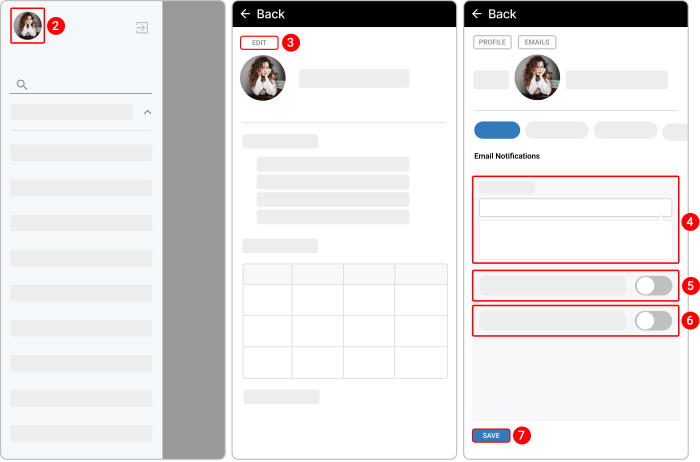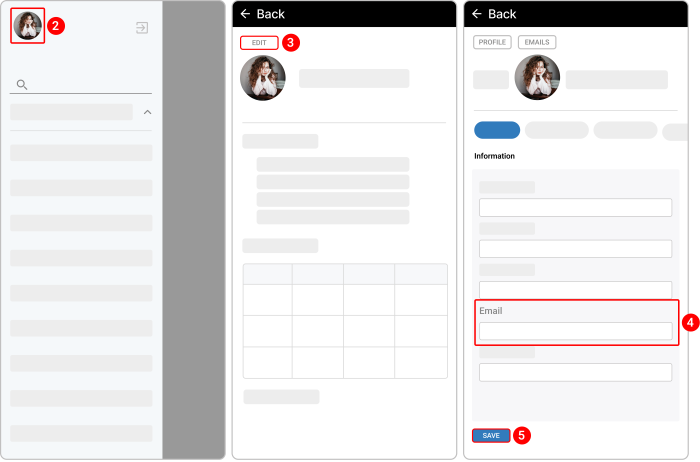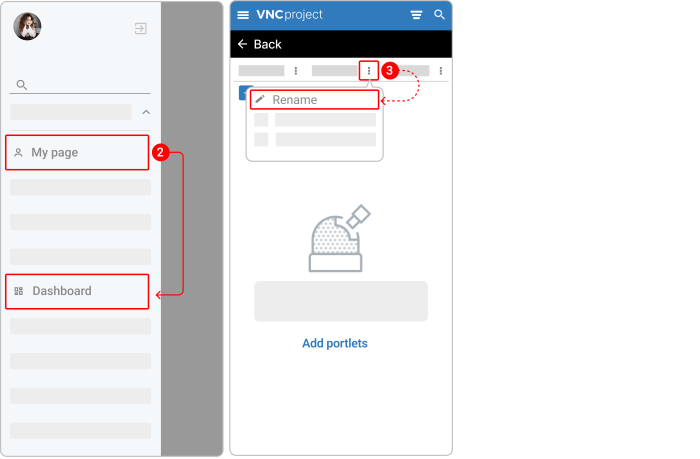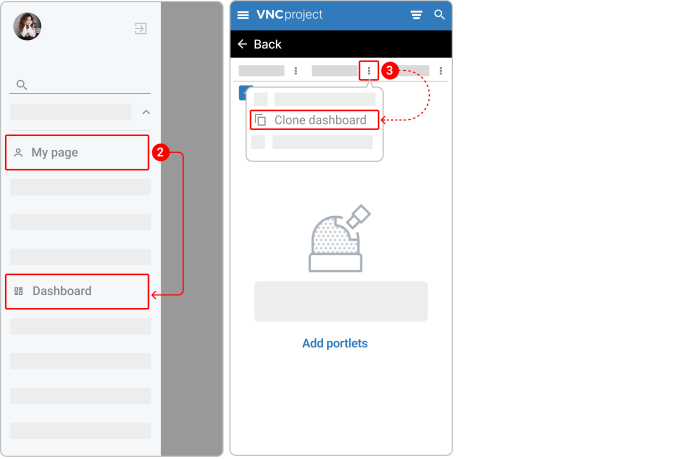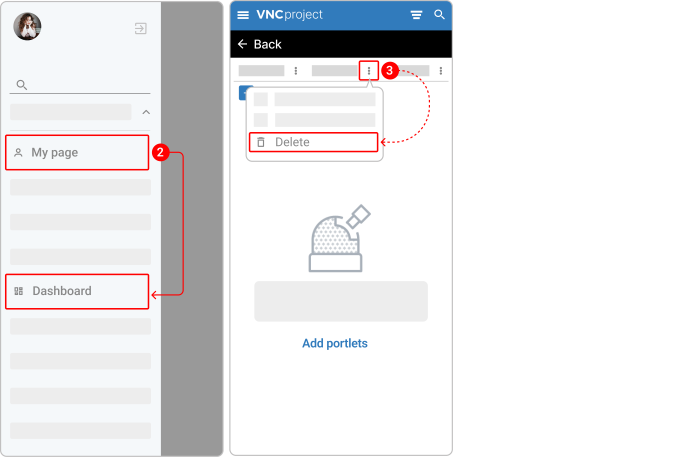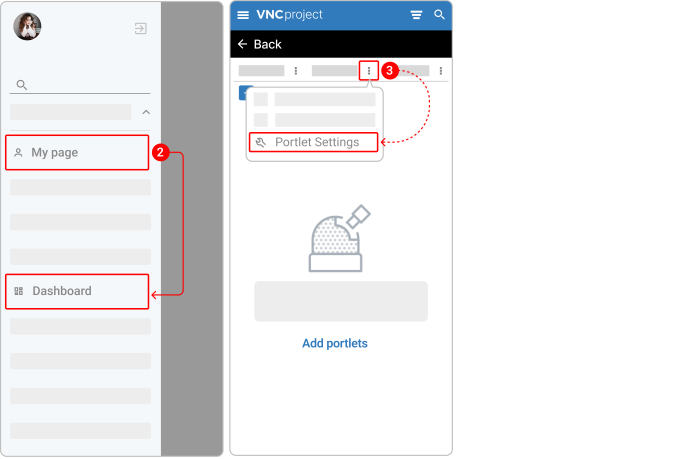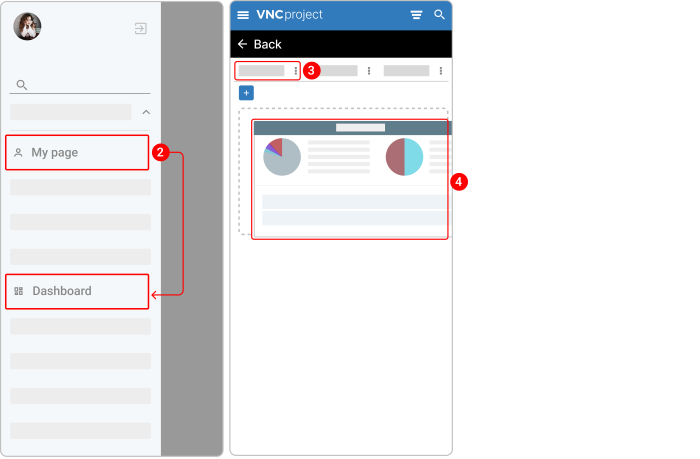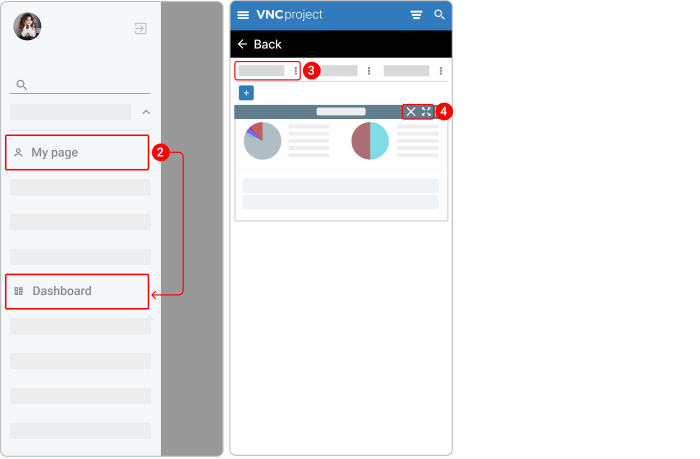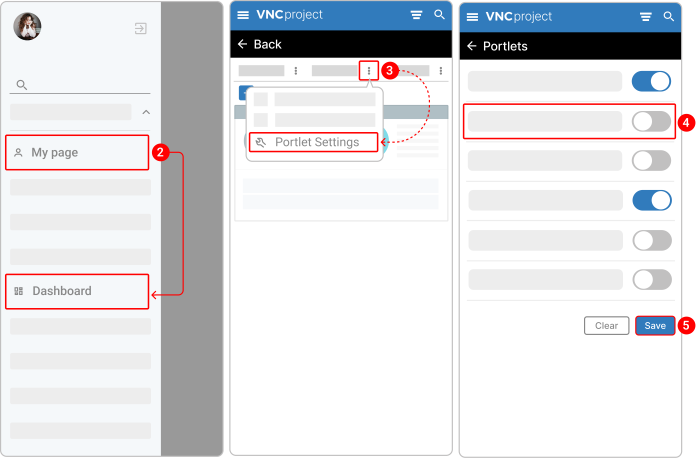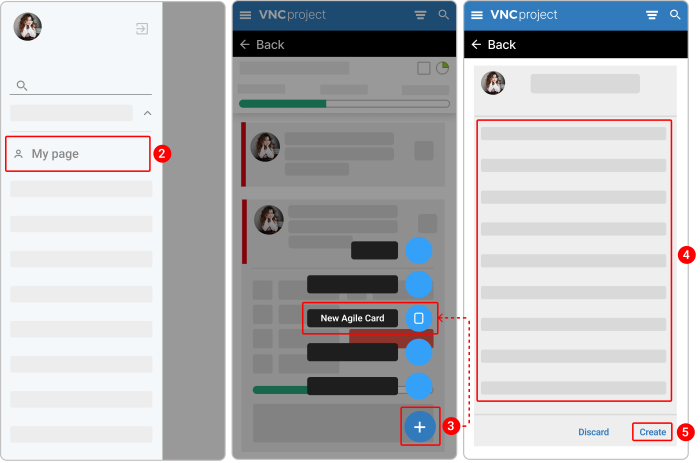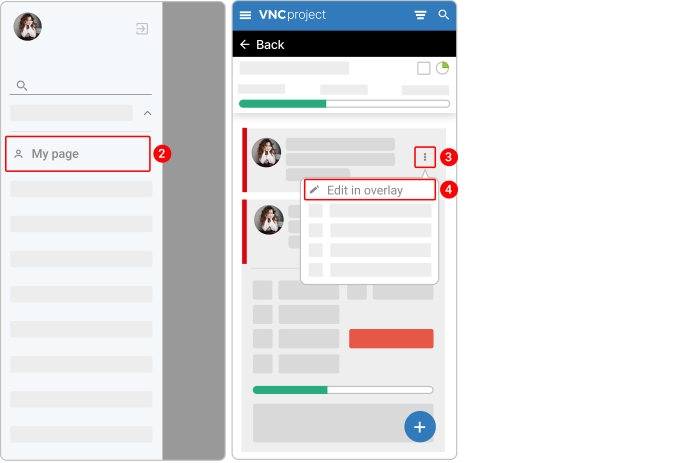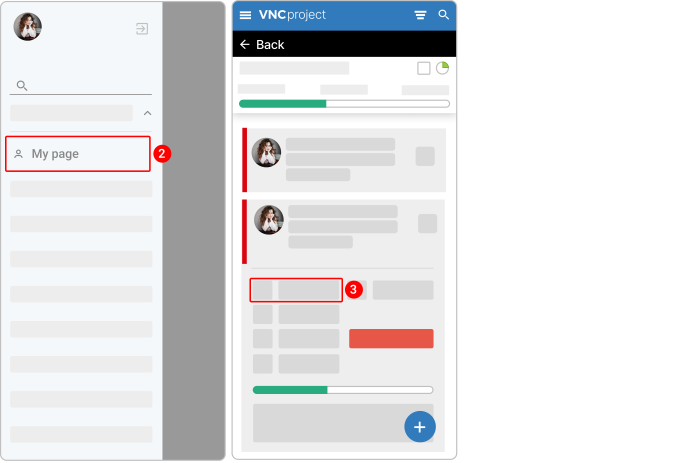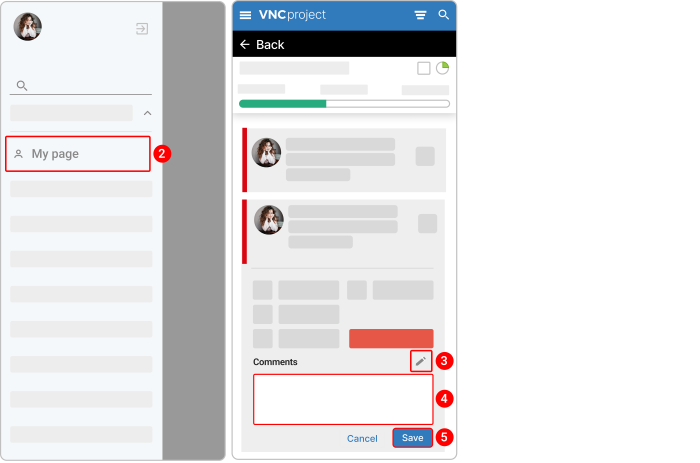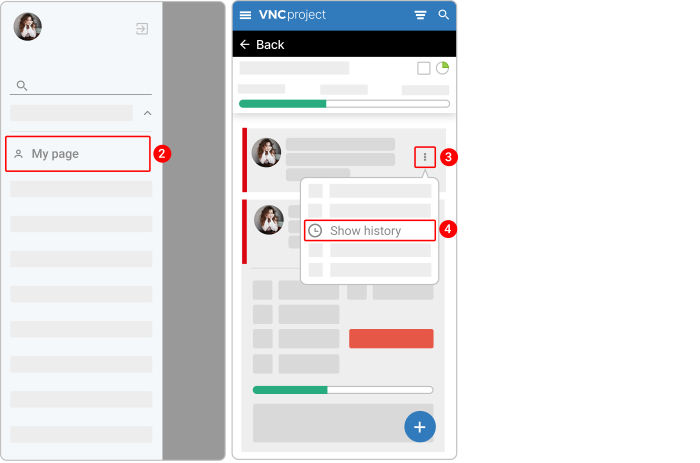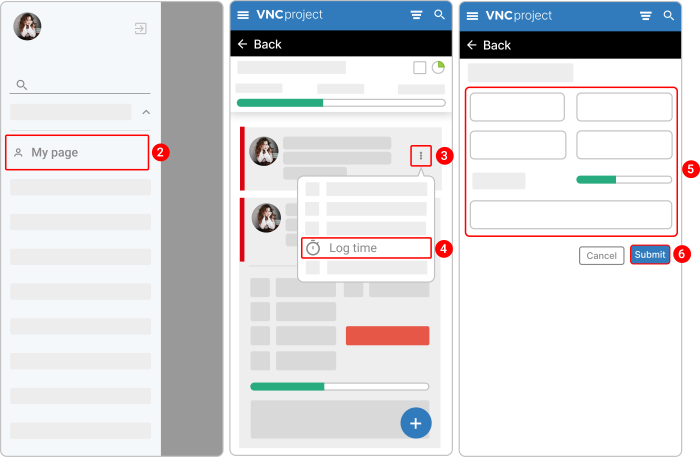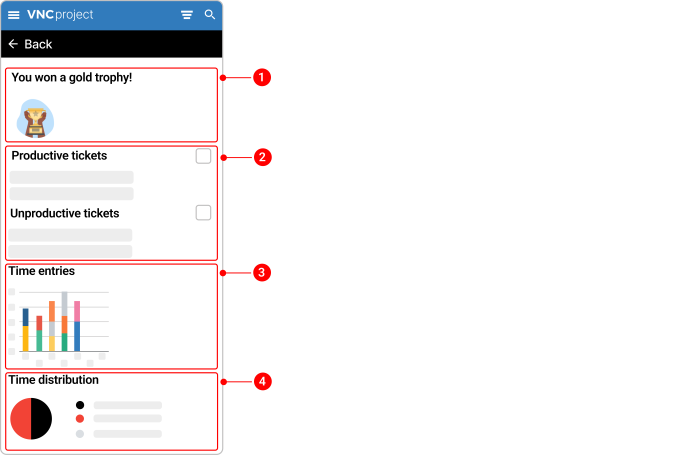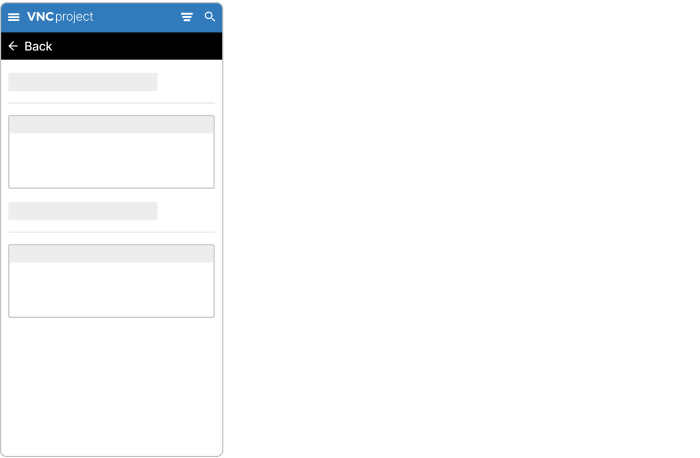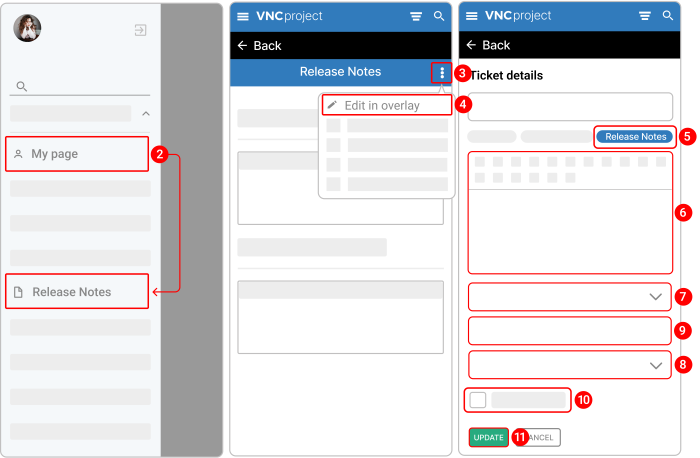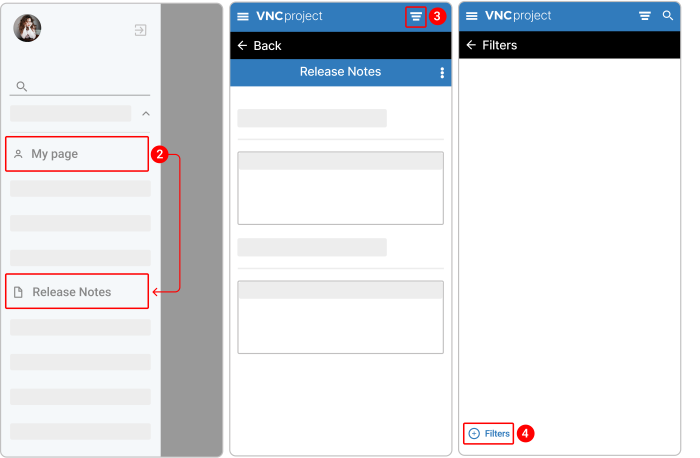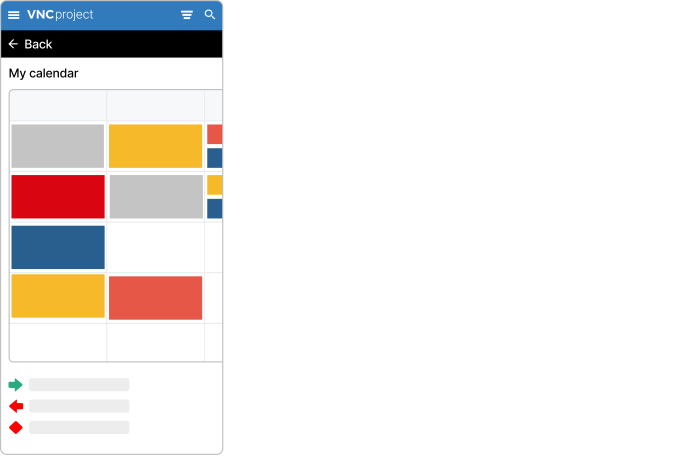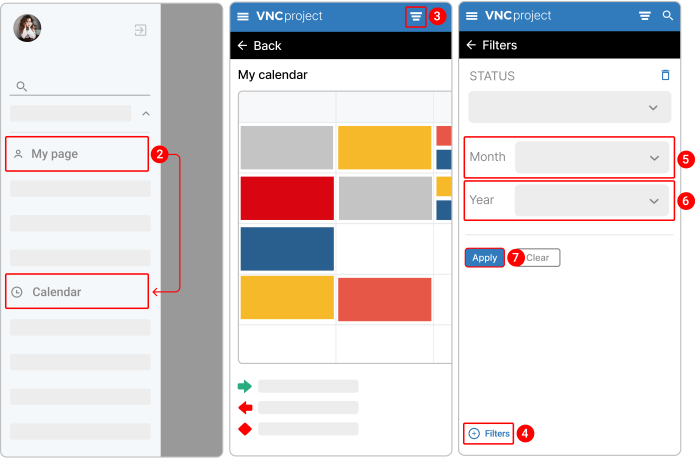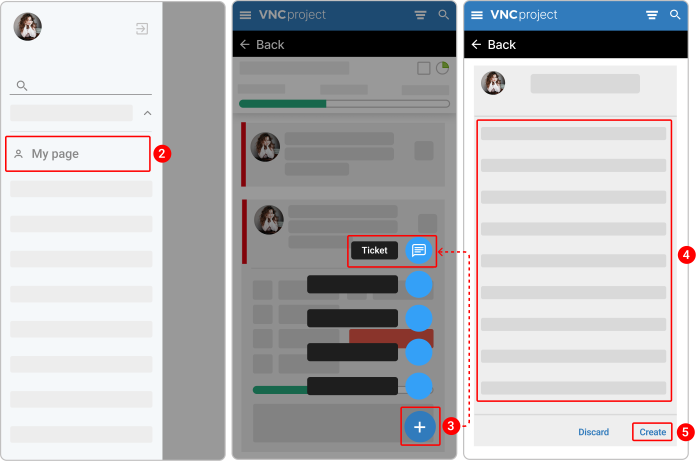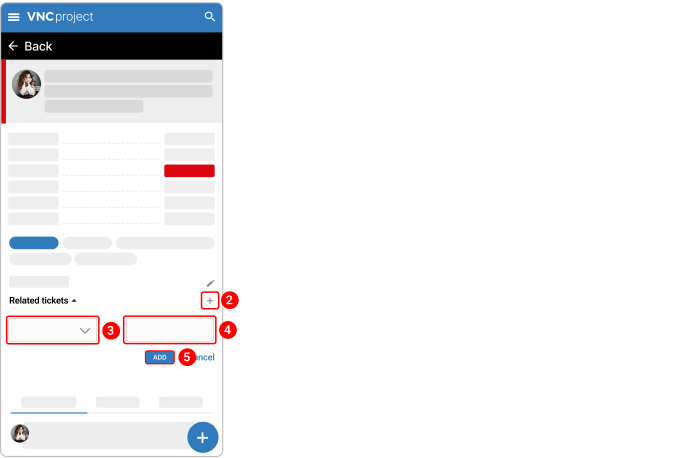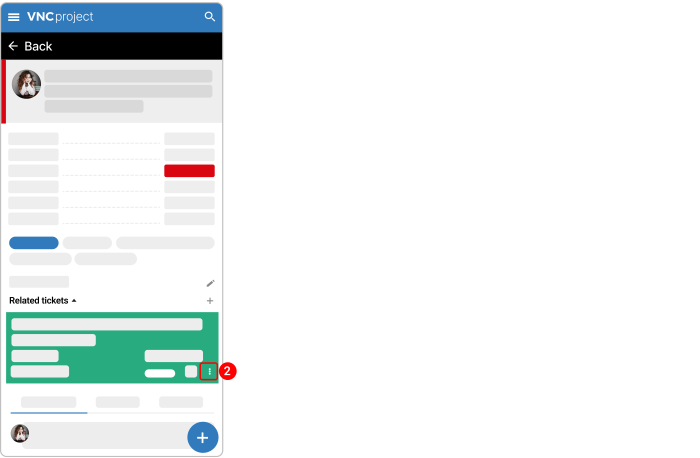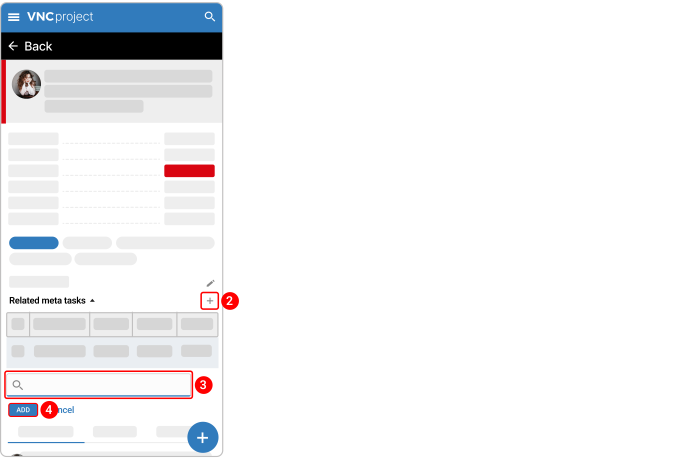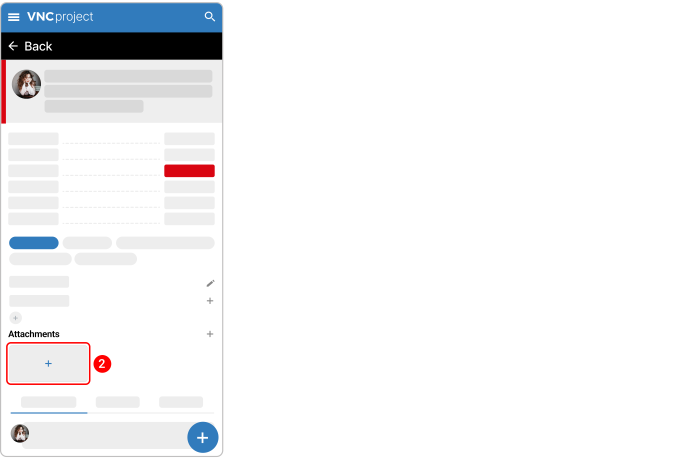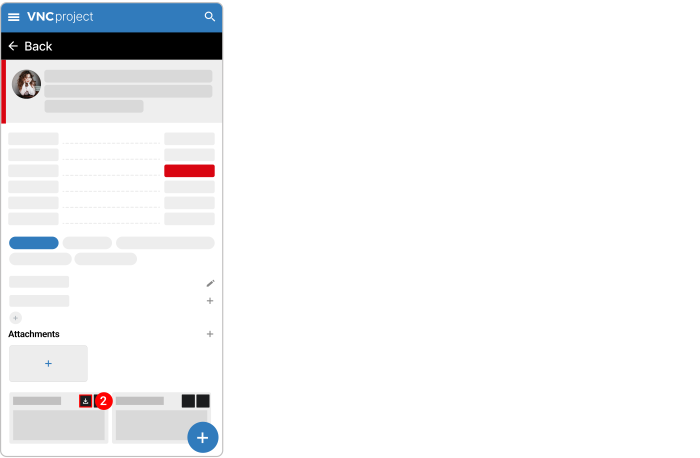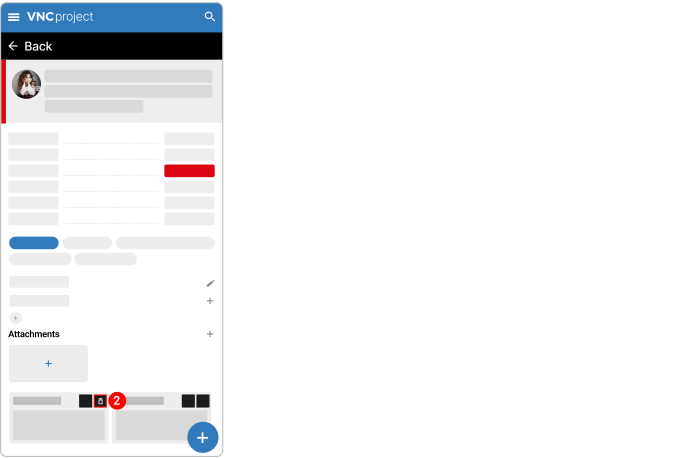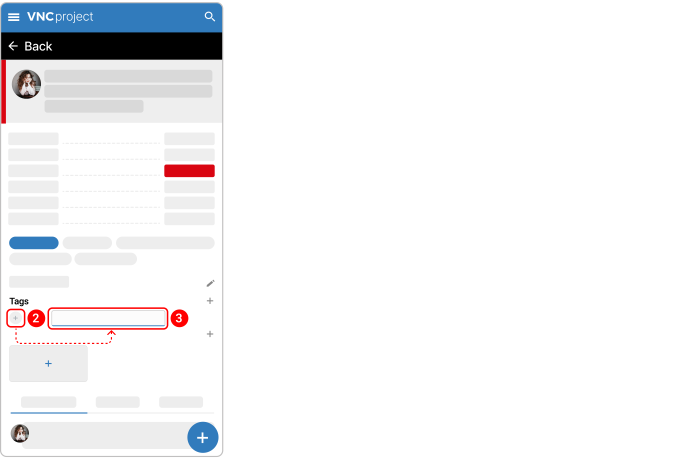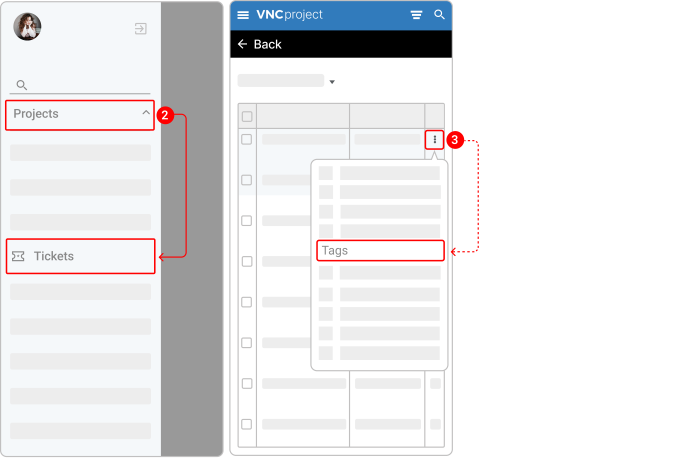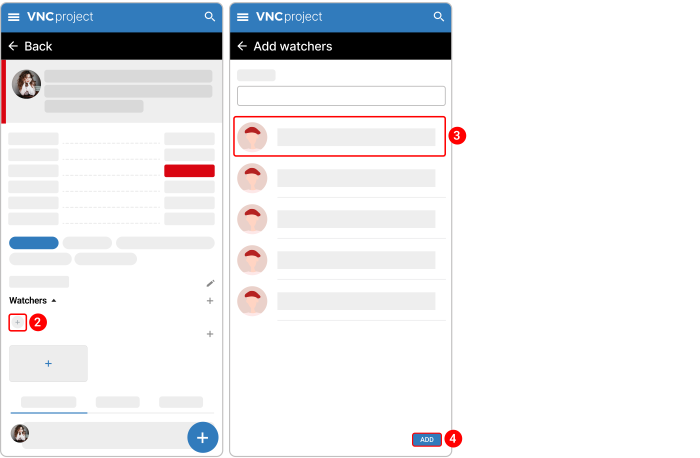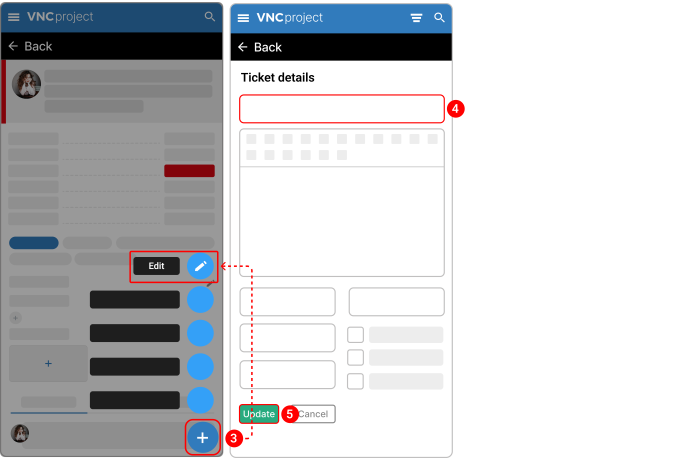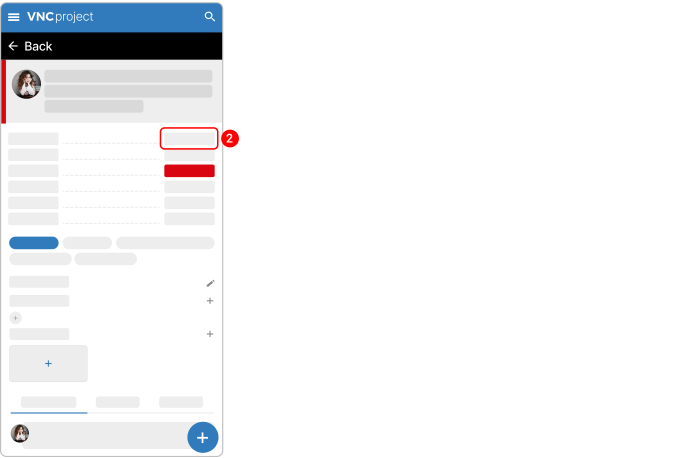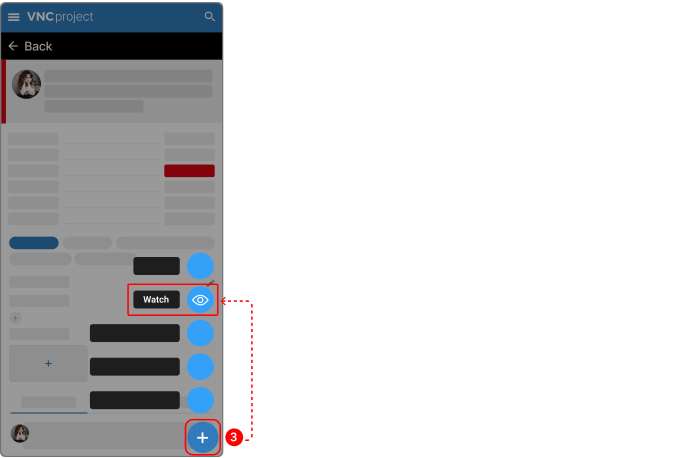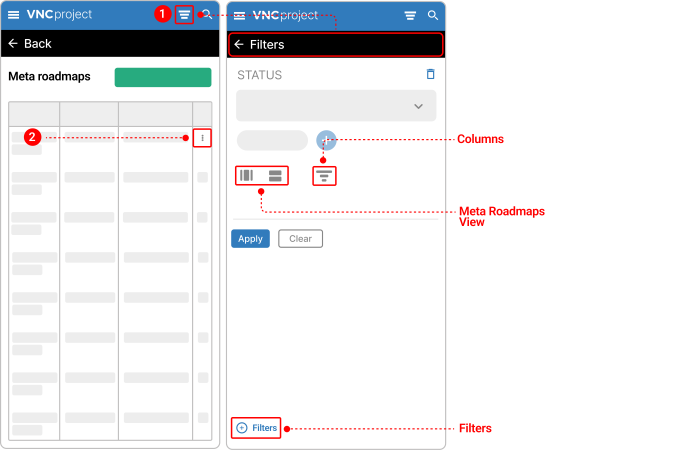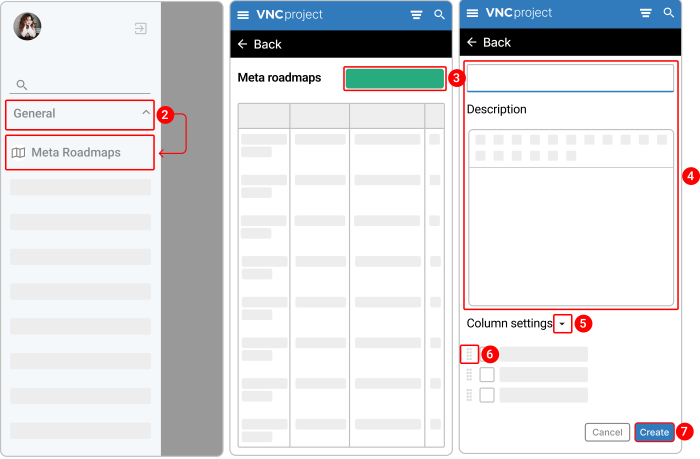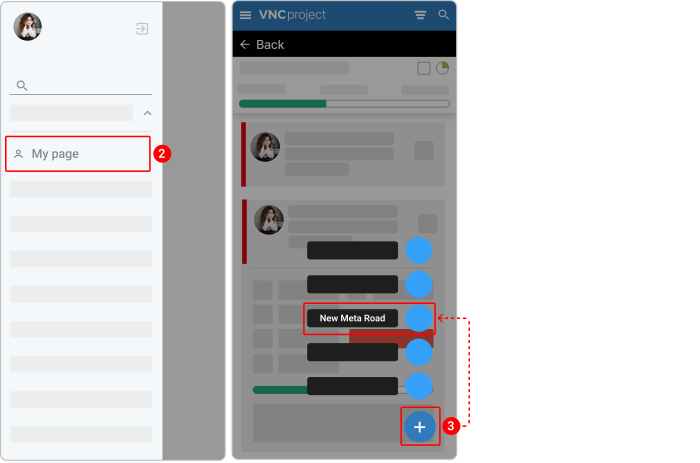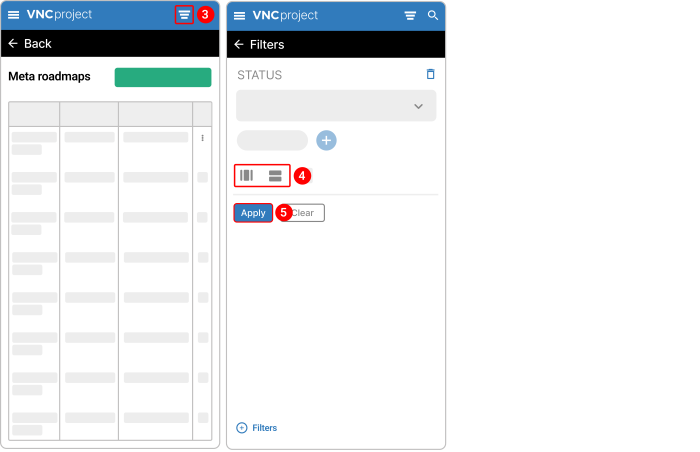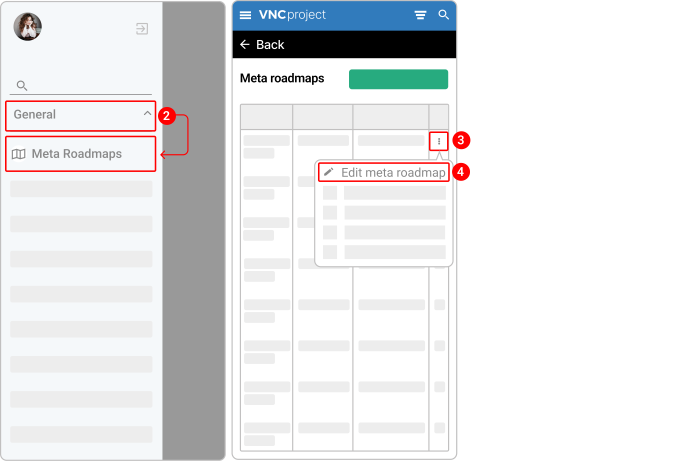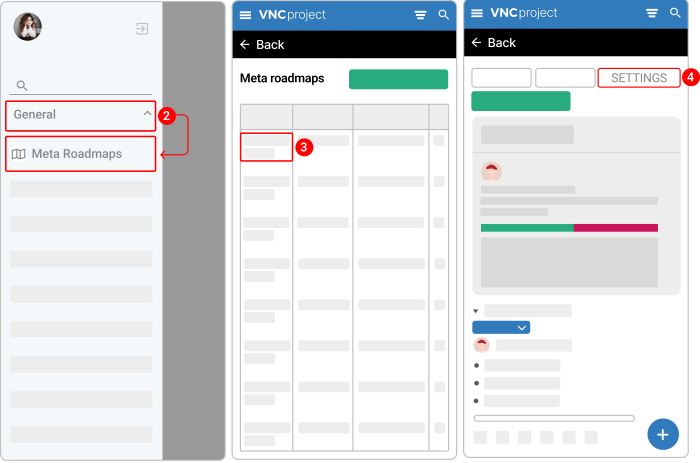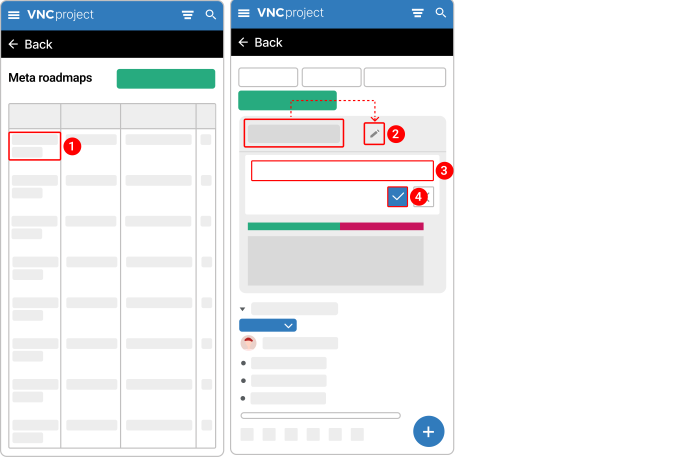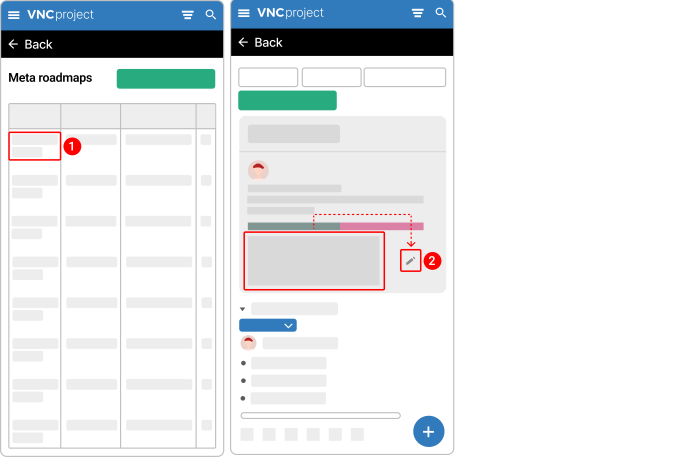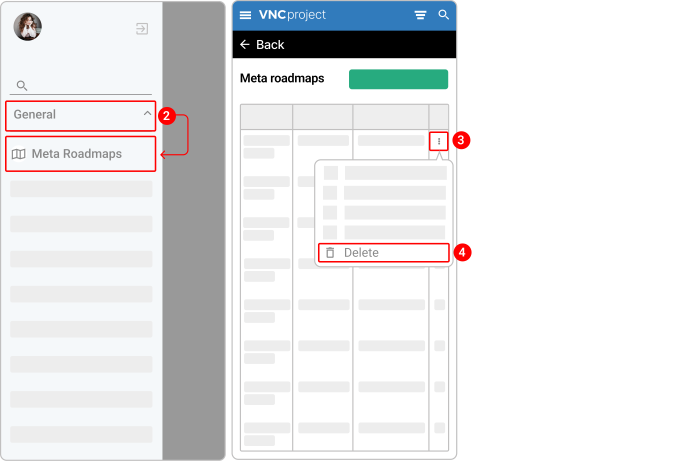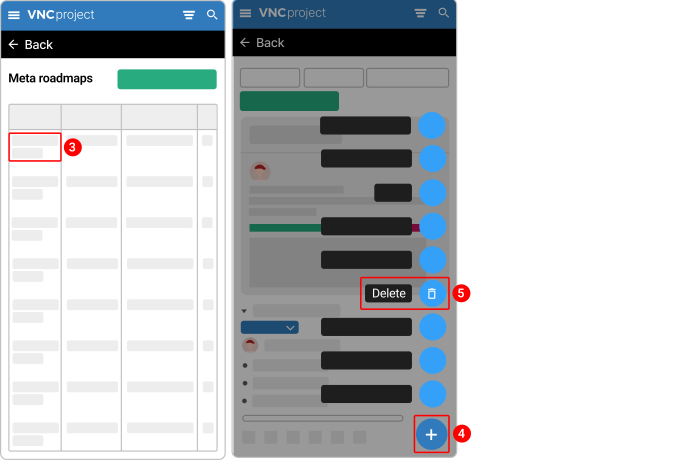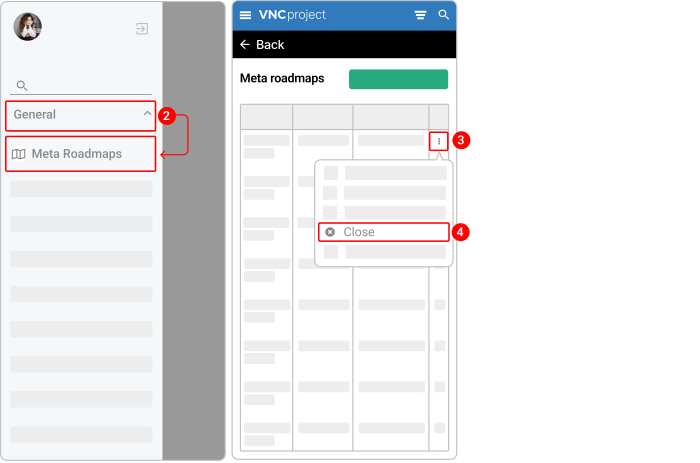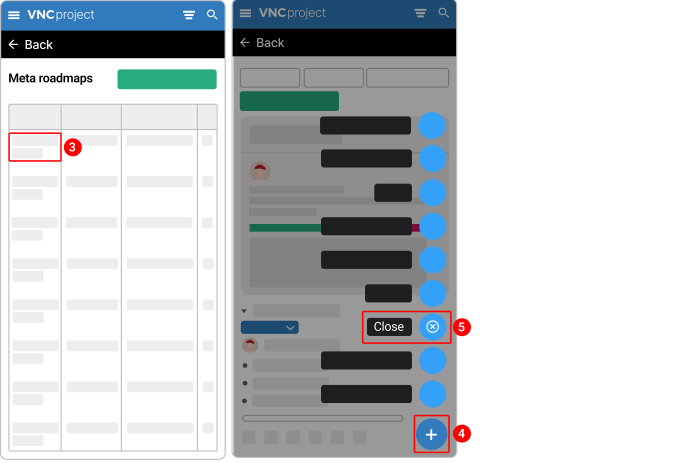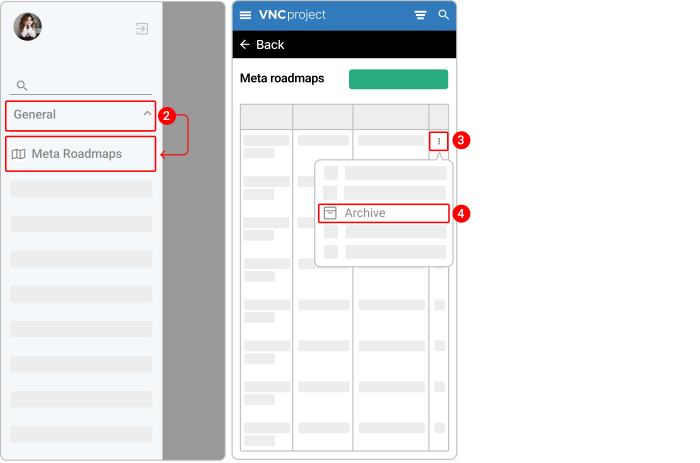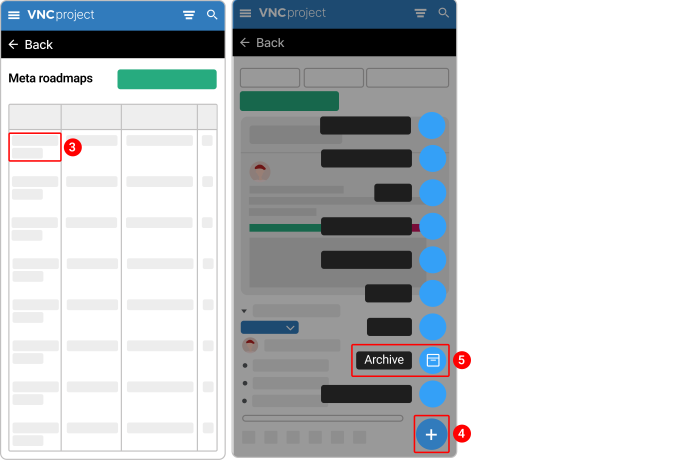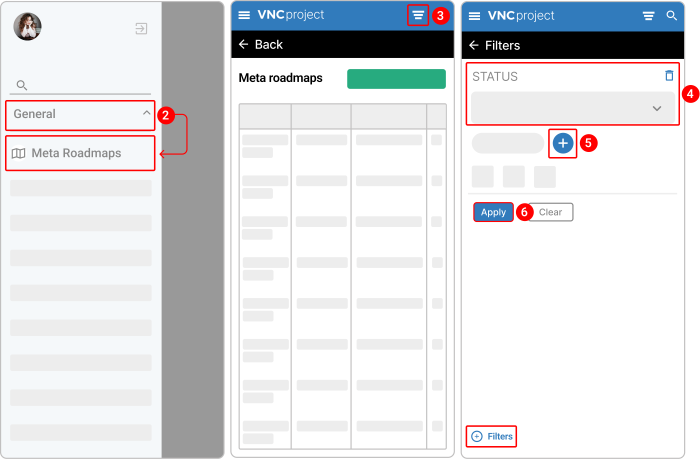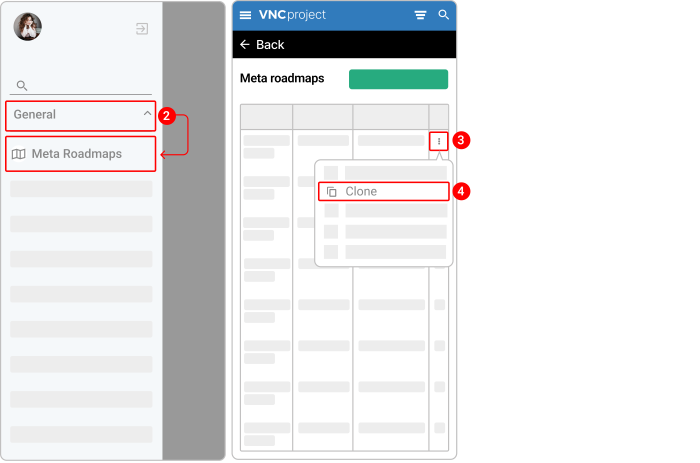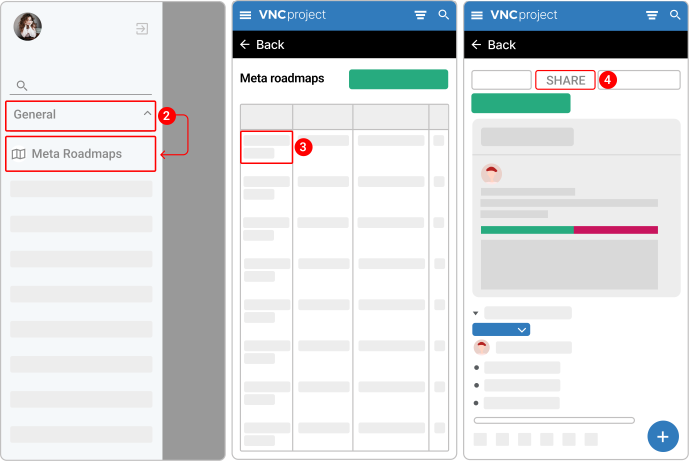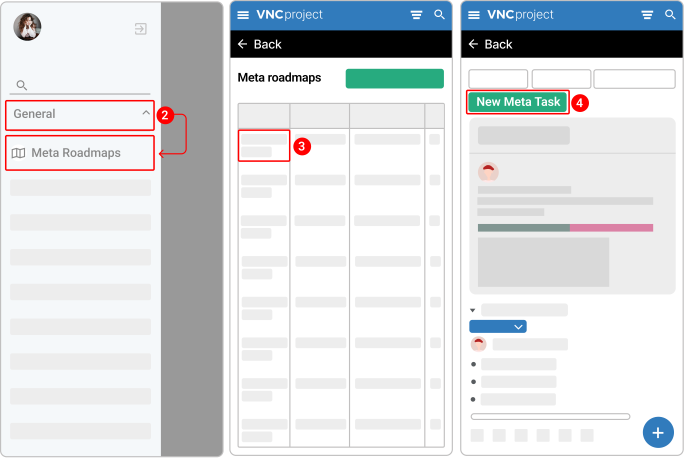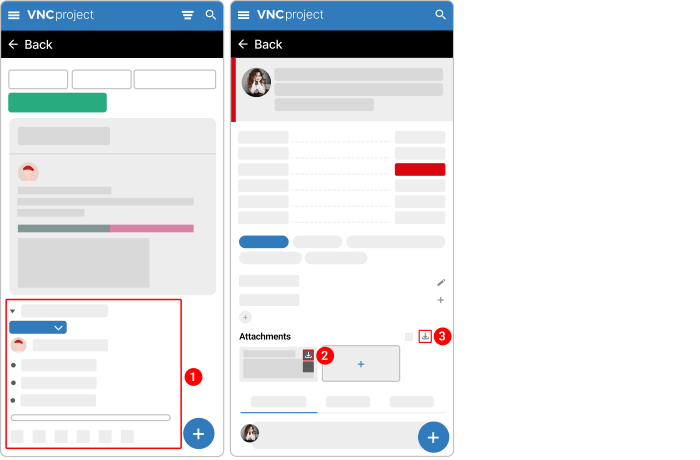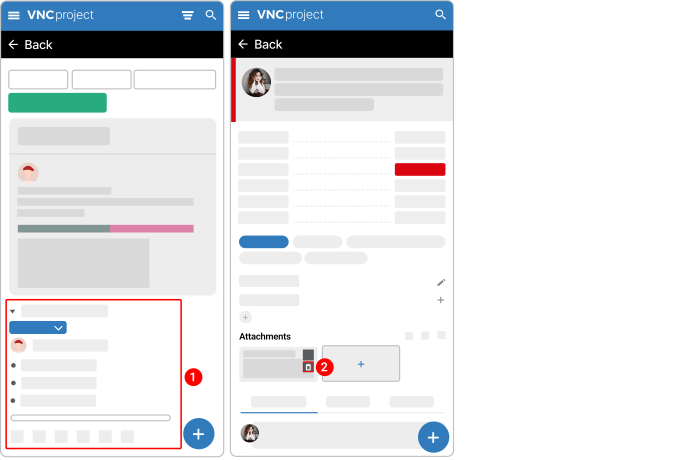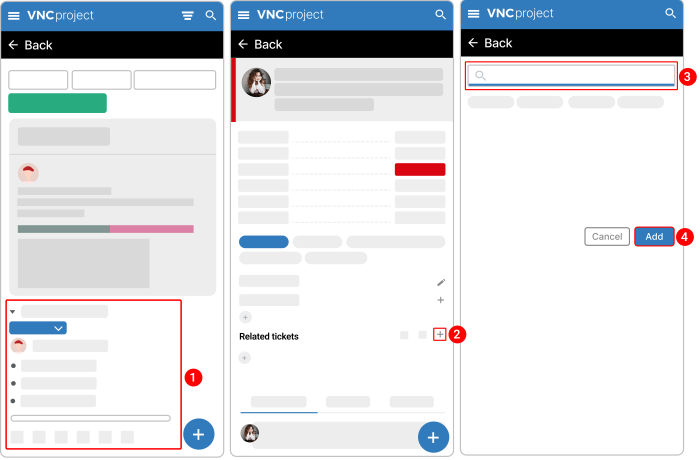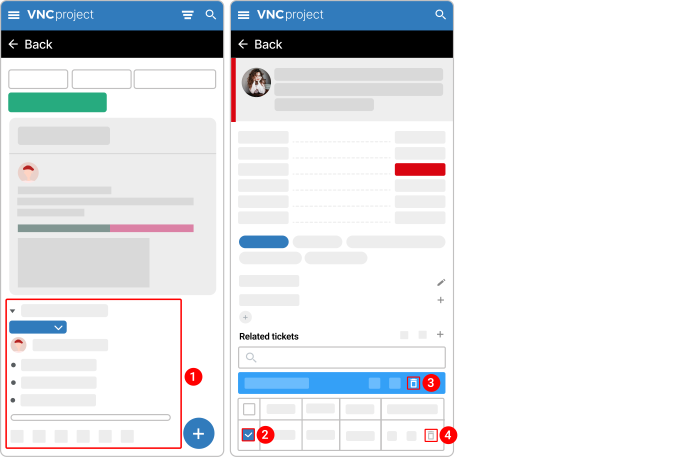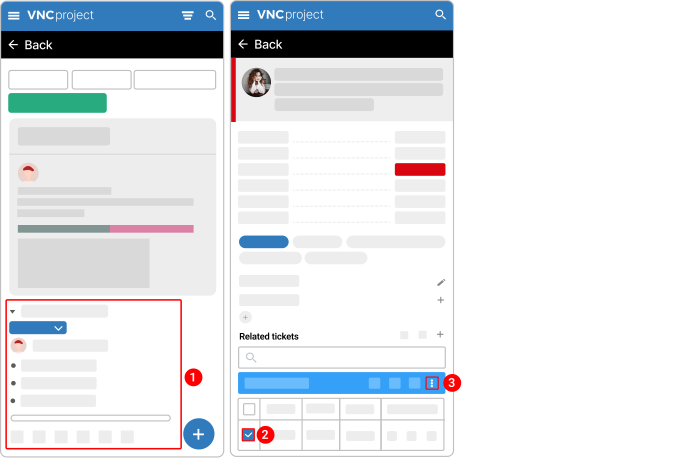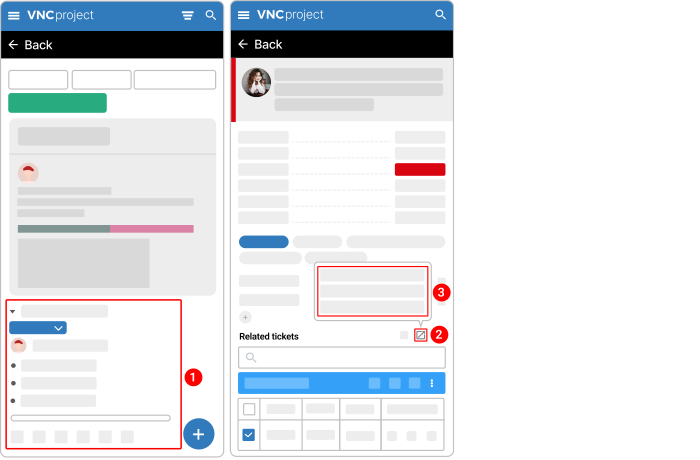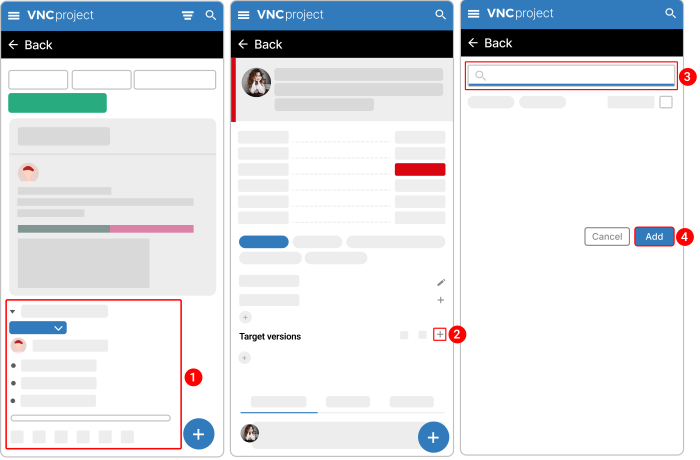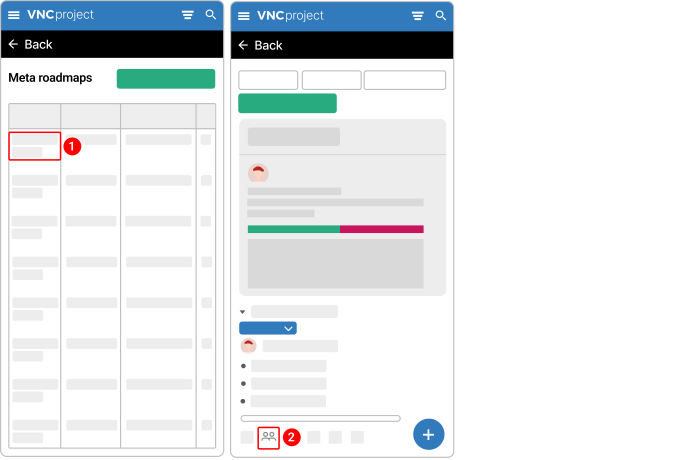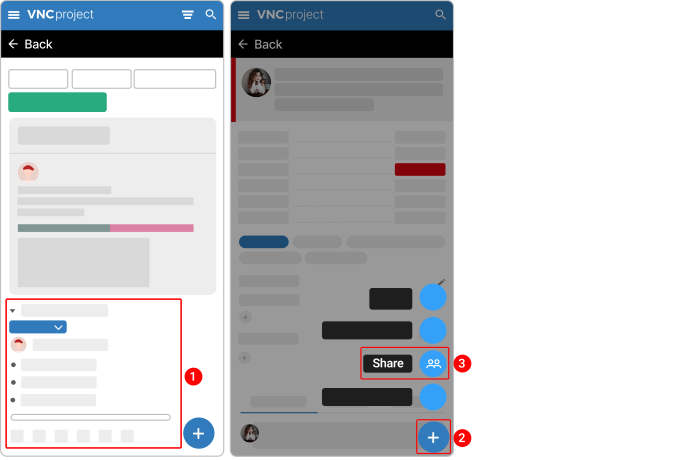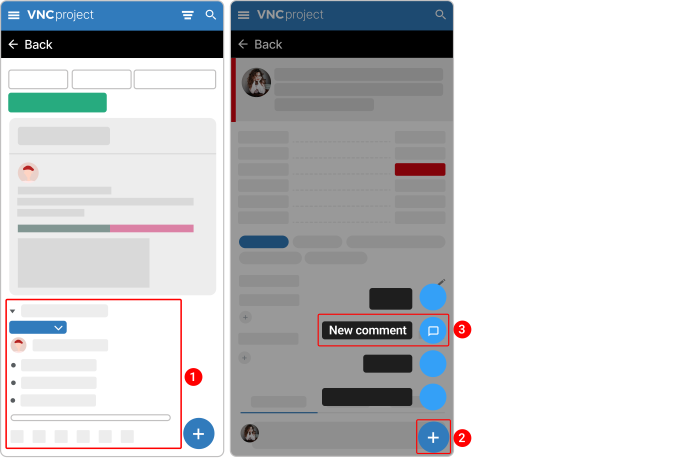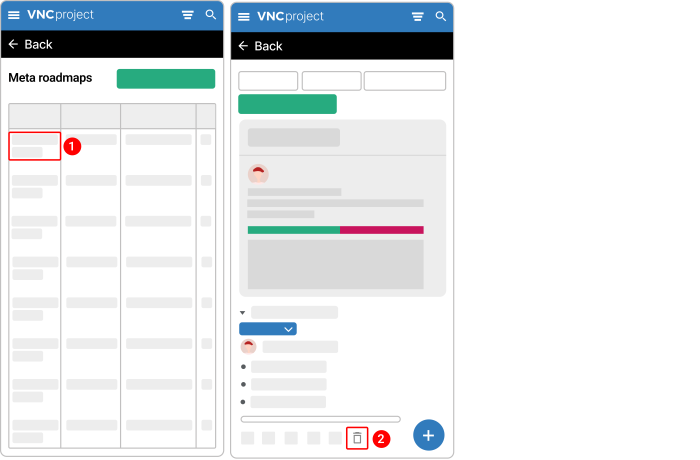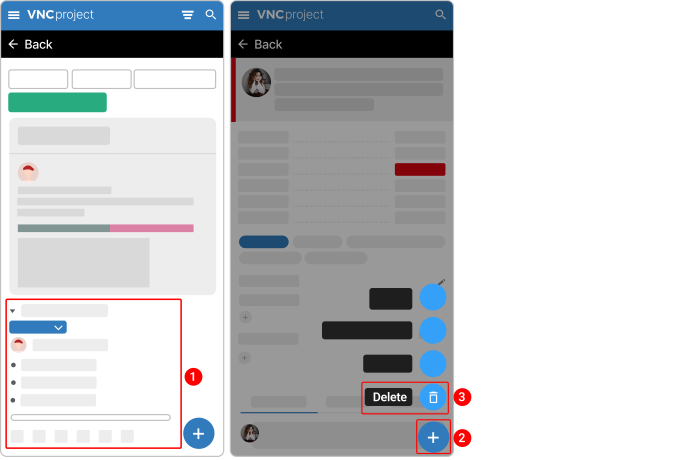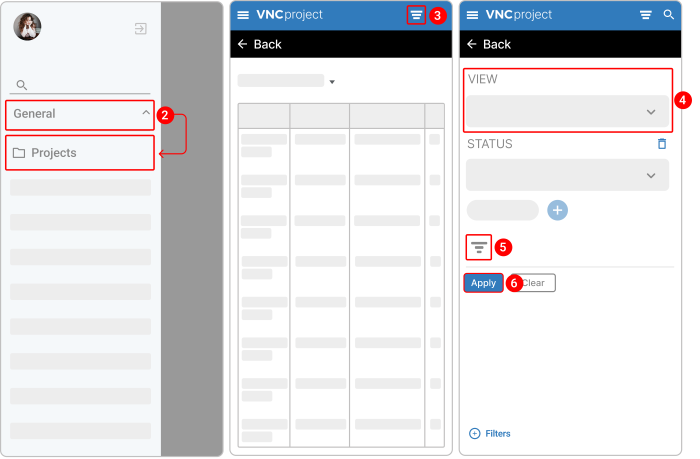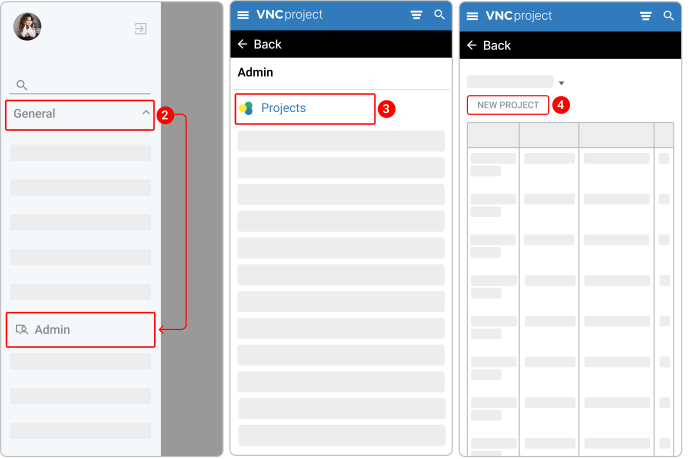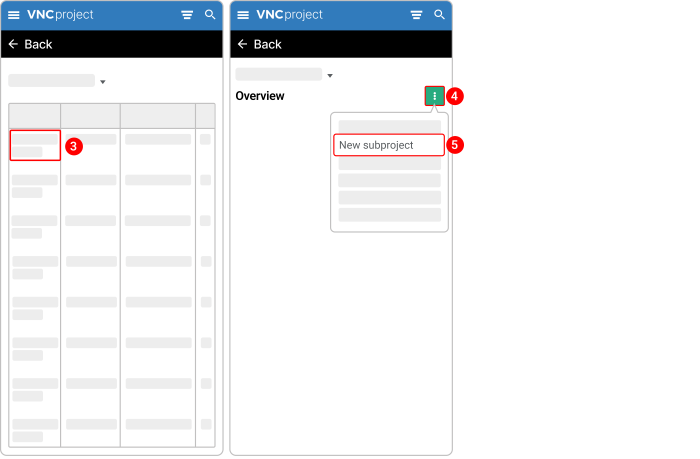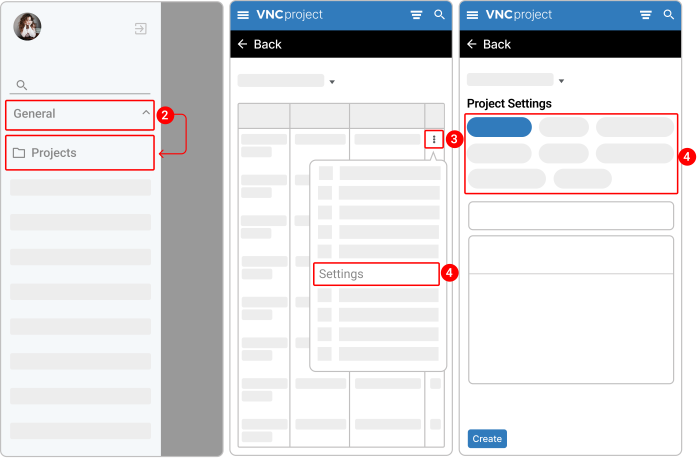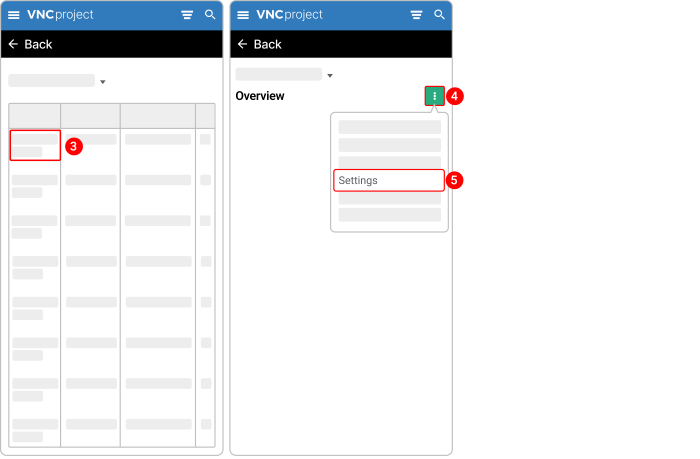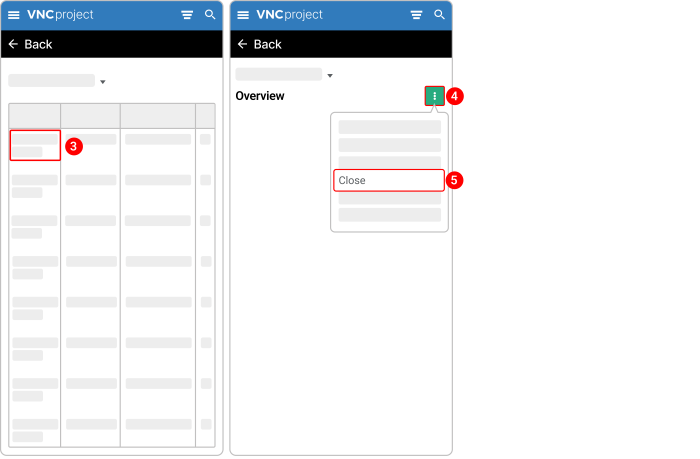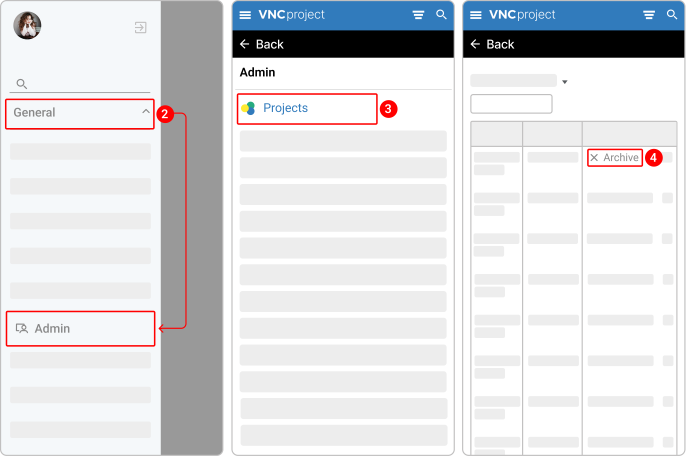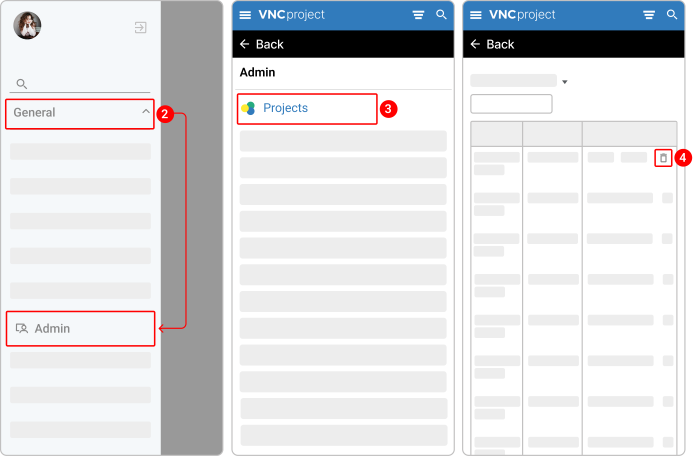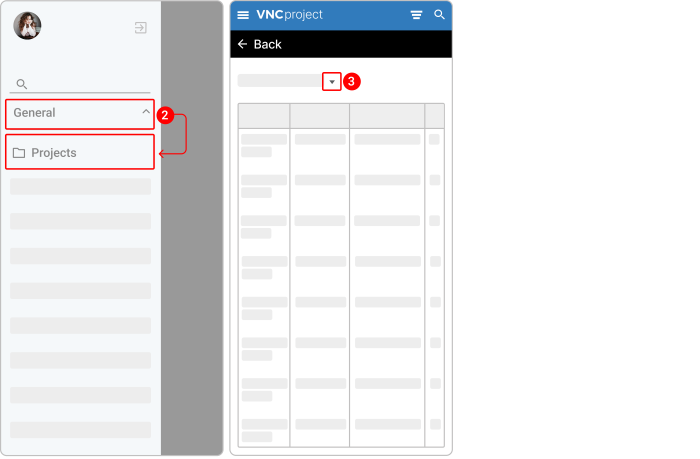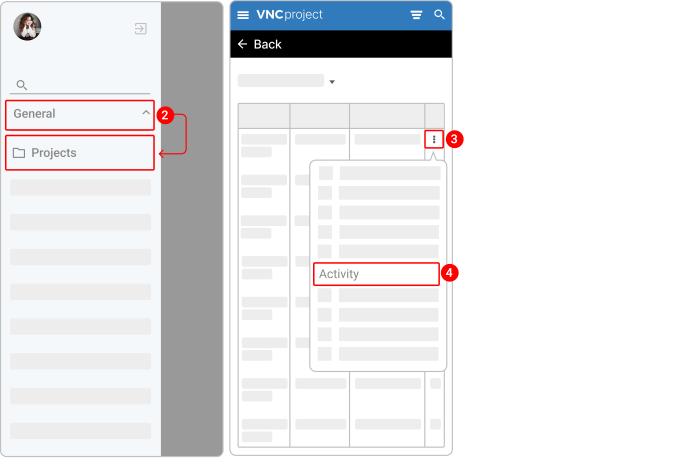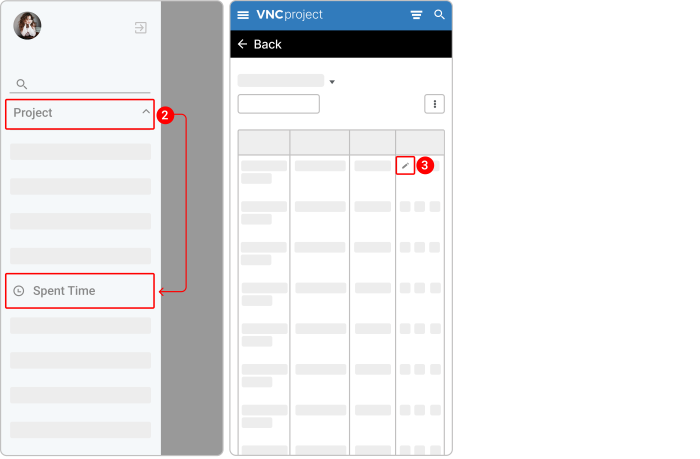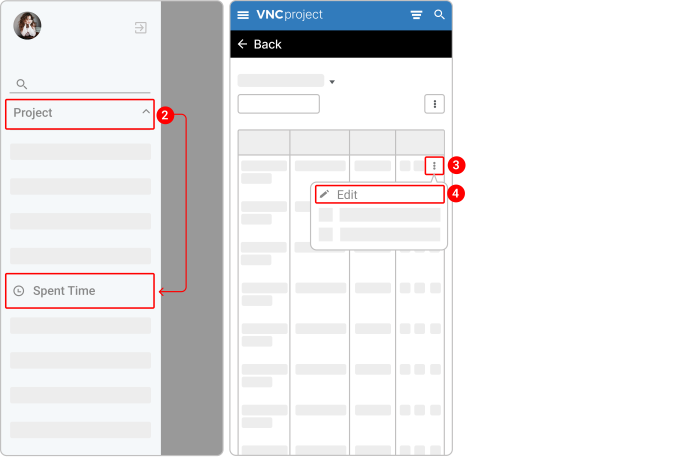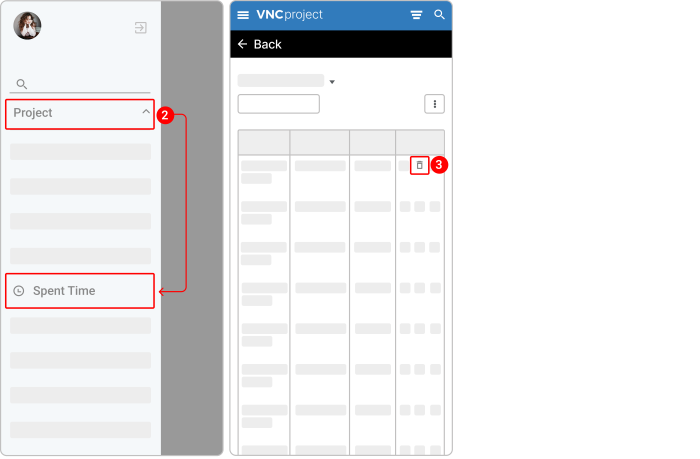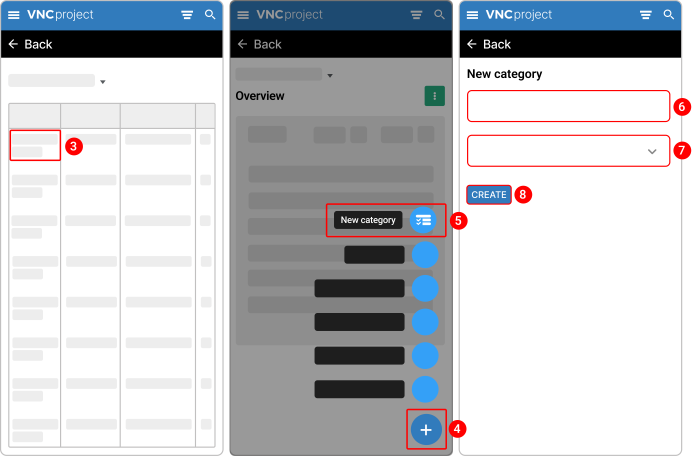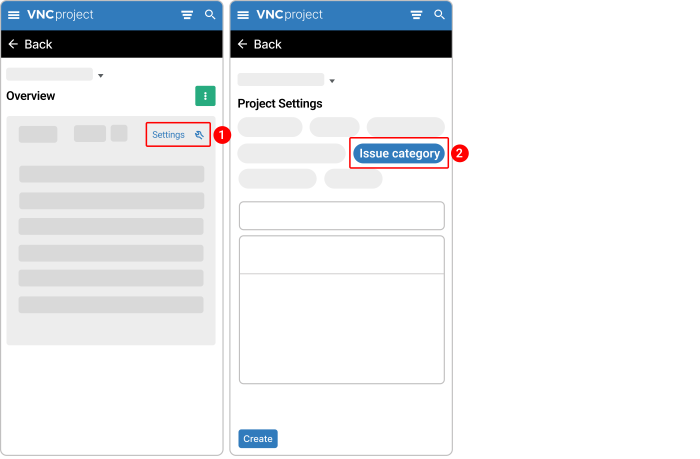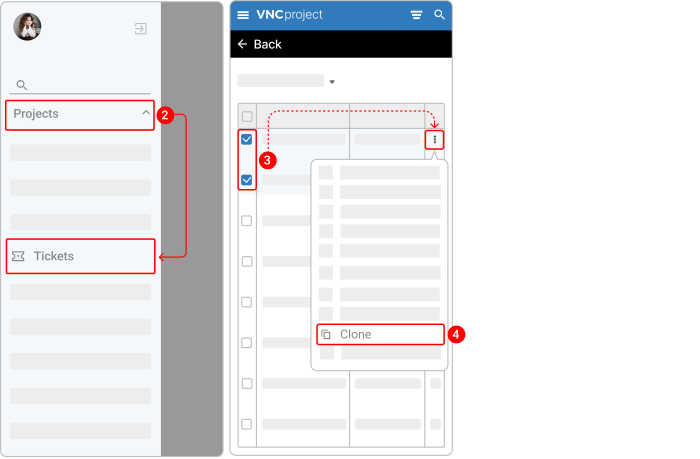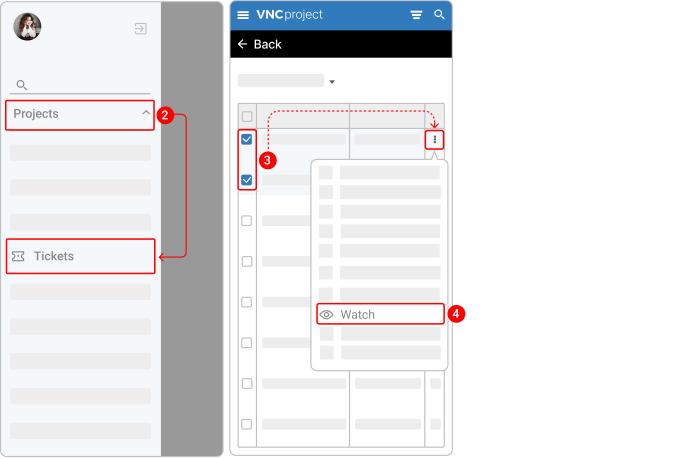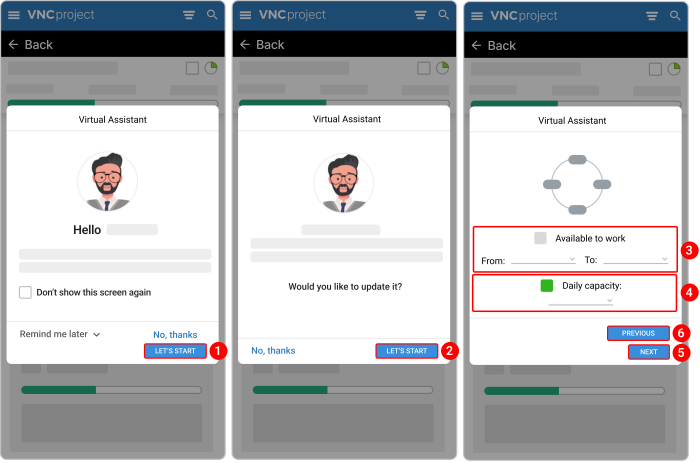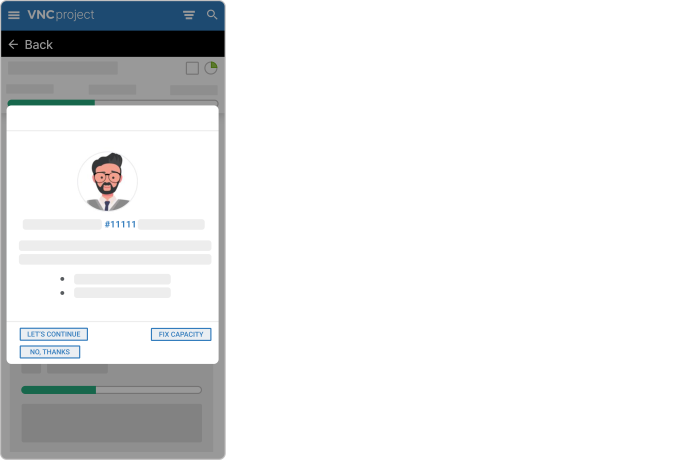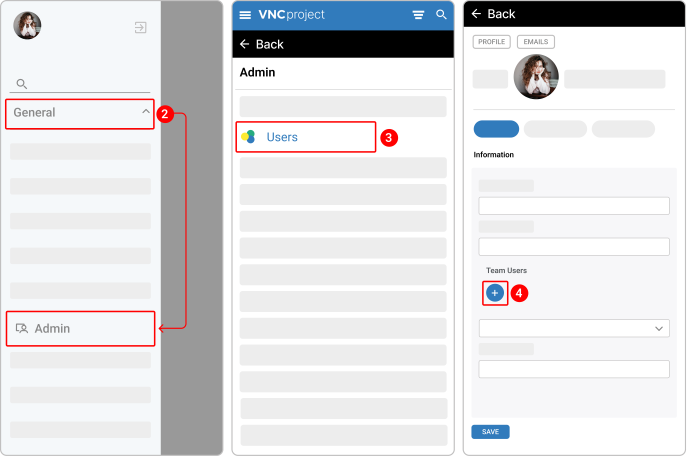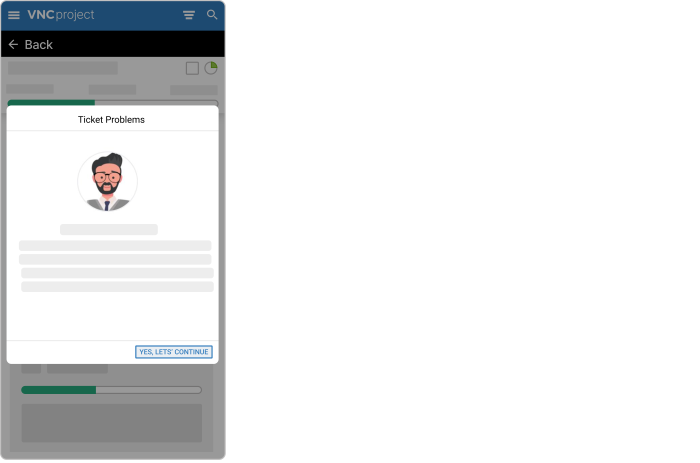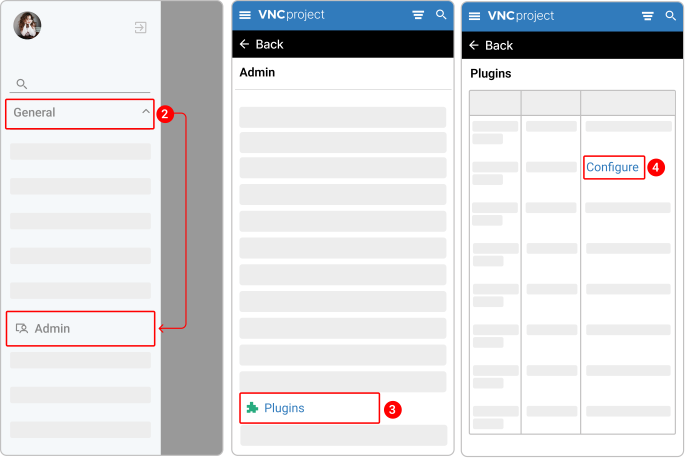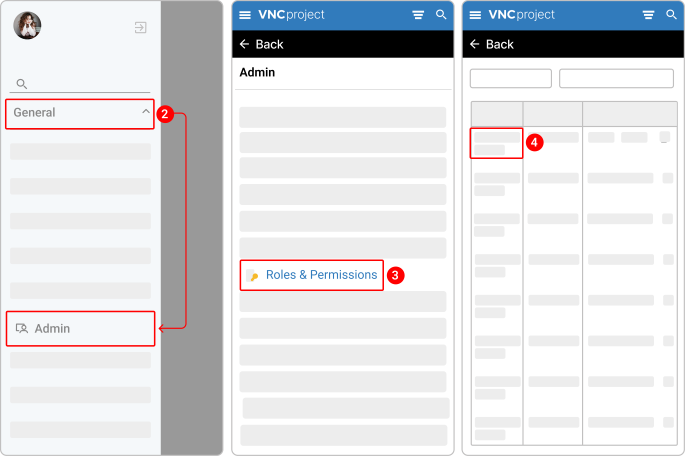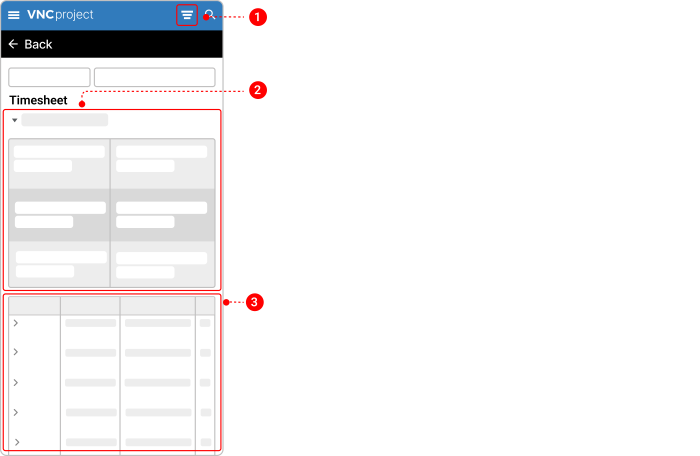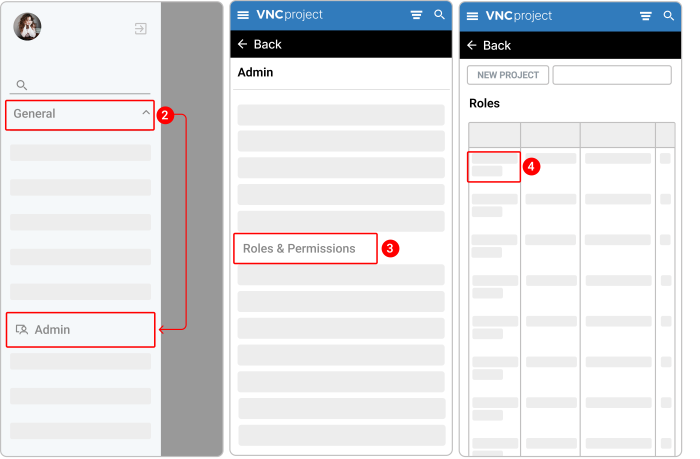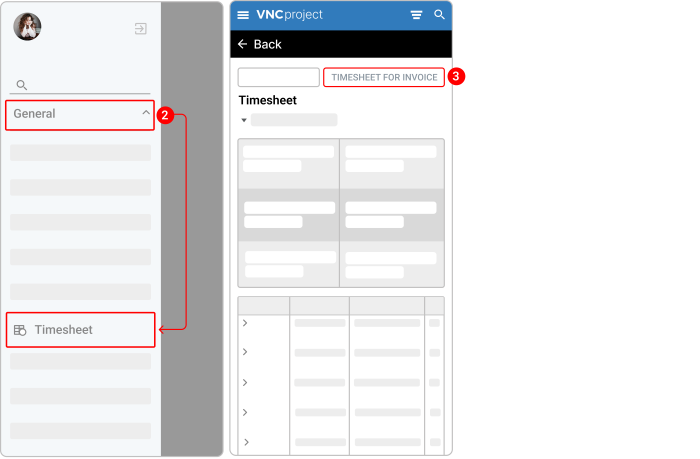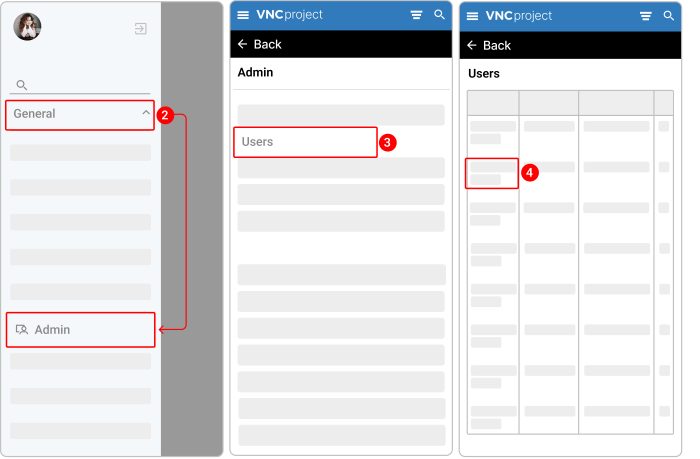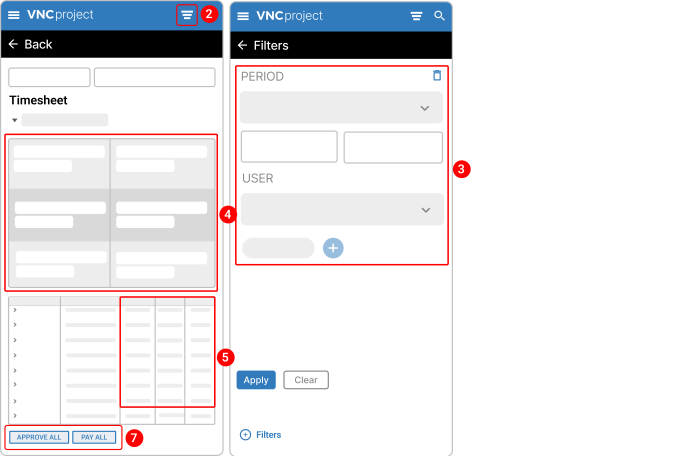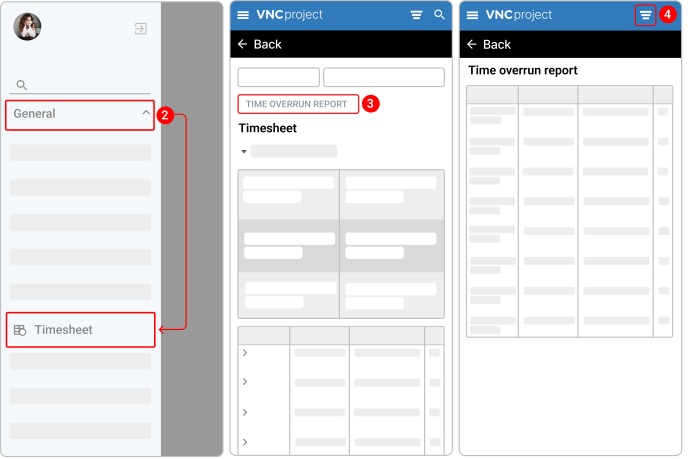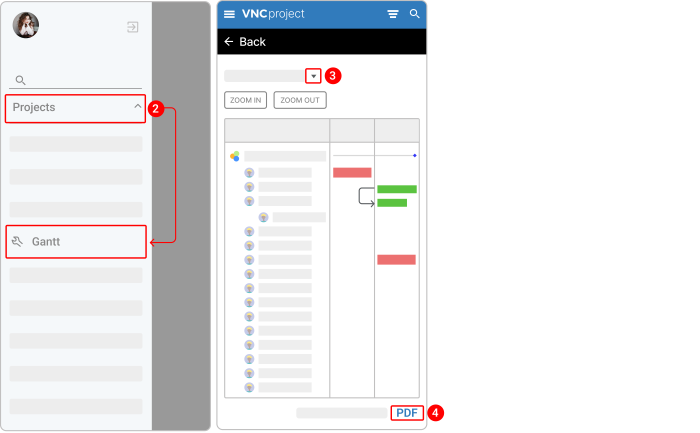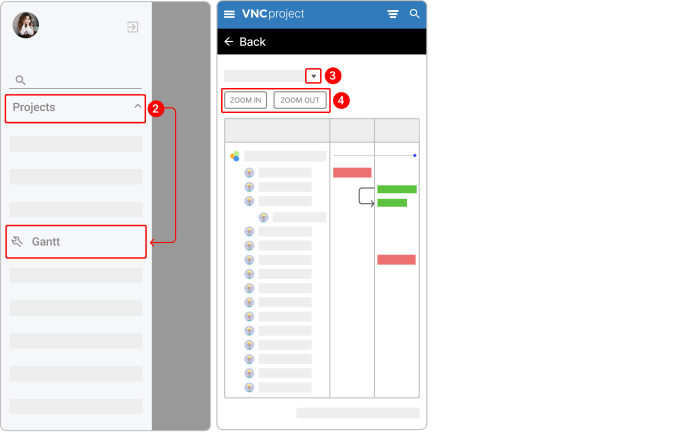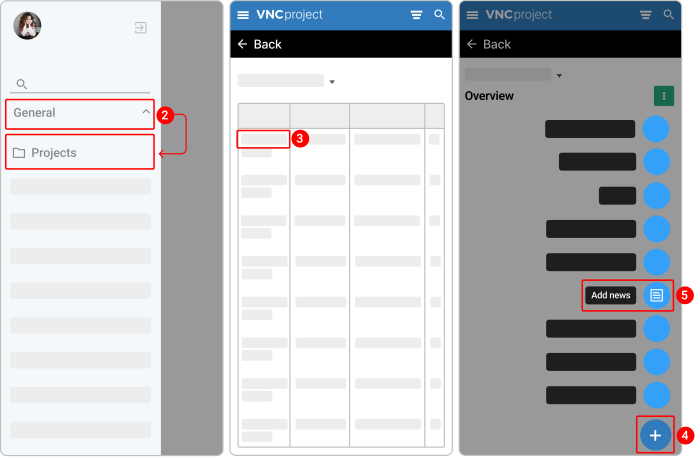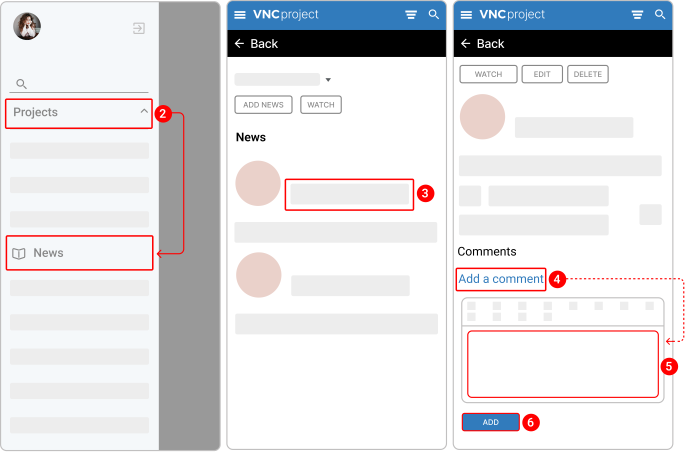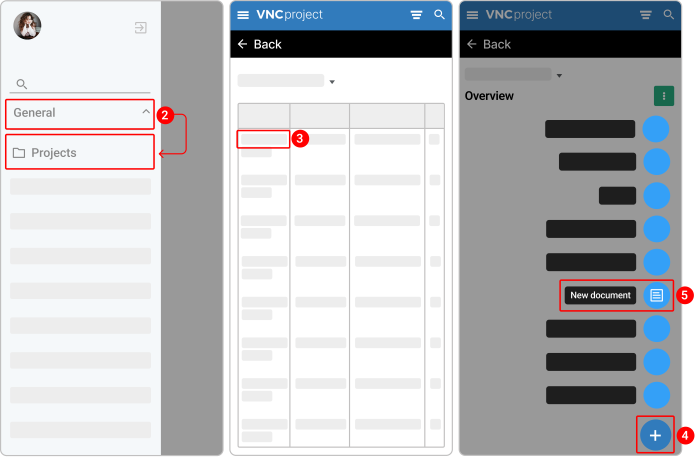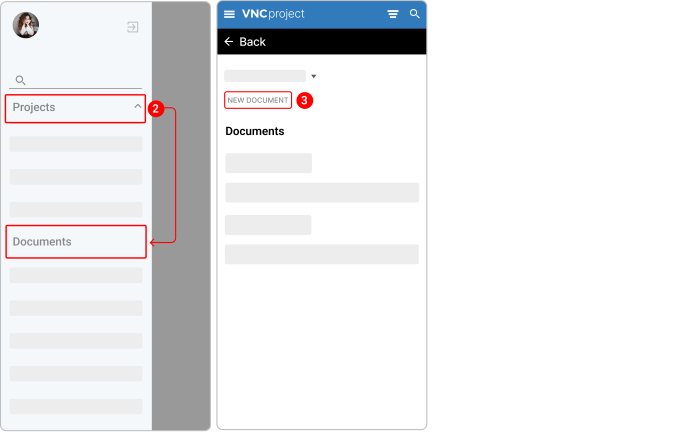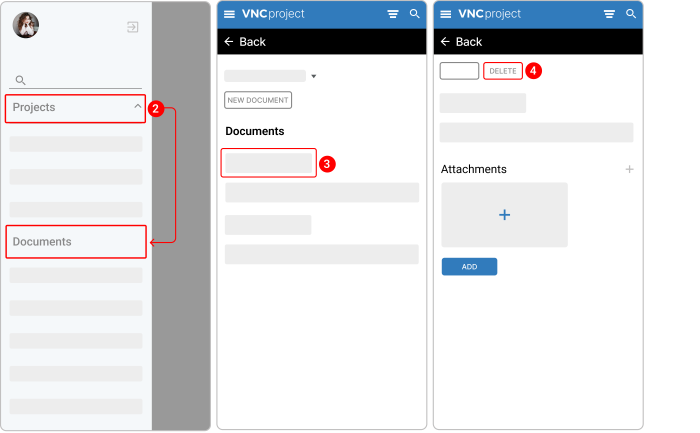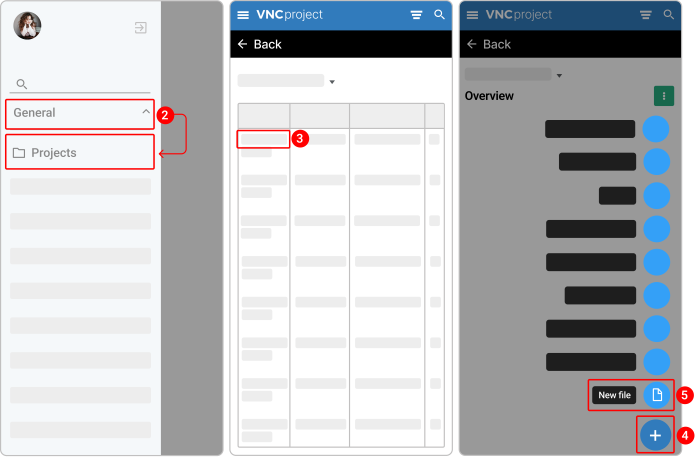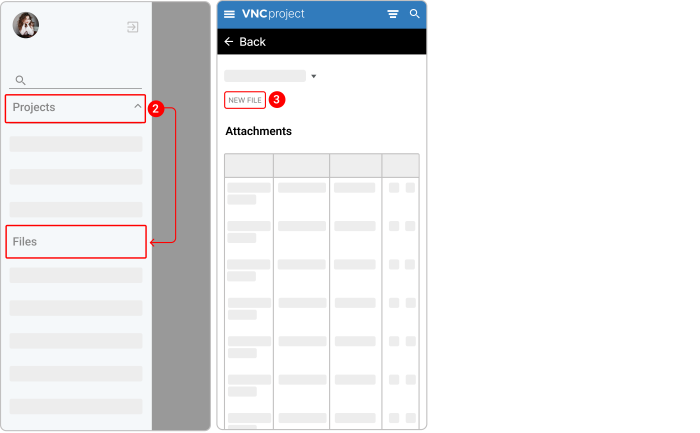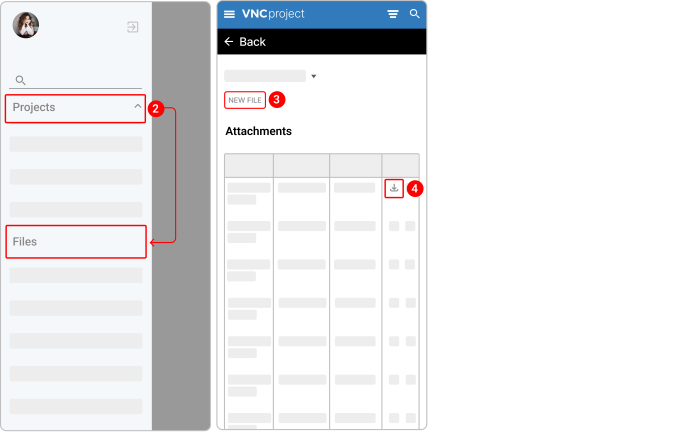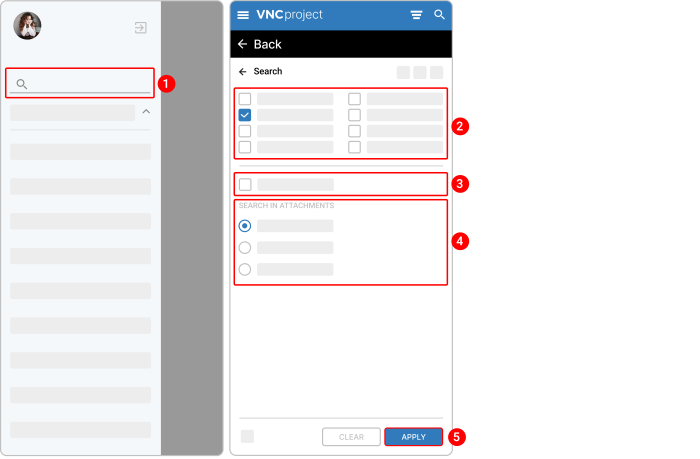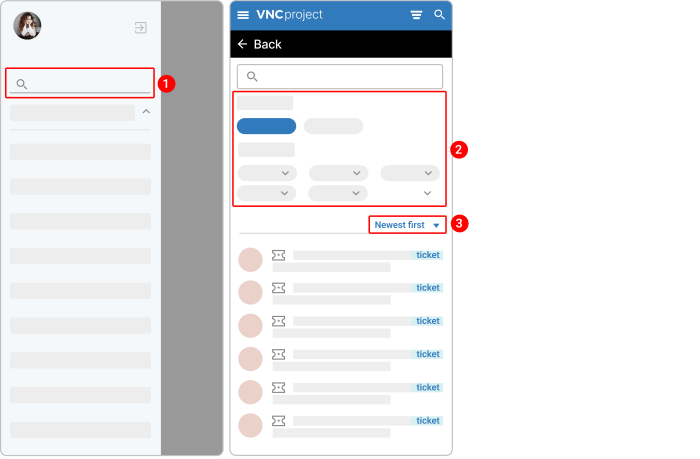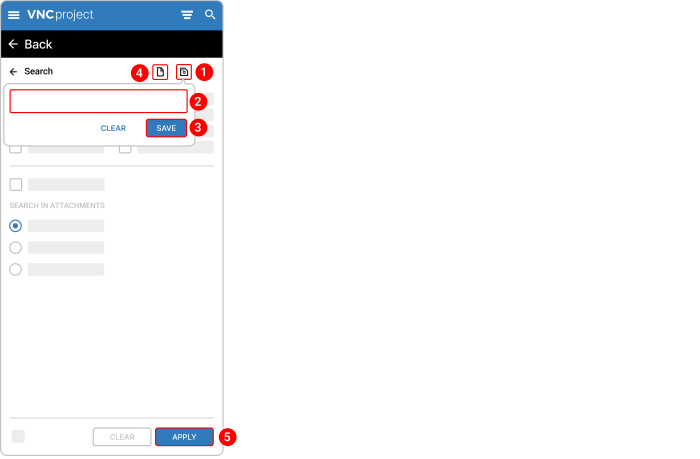VNCproject App User Manual¶
Getting started¶
Edit the account information¶
You can edit information like your email address, full name, period of payment, and display language.
- In the upper left, tap the hamburger menu icon
 .
. - Tap the avatar icon.
- Tap Edit right above the avatar icon. You will be redirected to the account page.
- Under the Information section, update your basic info.
- Tap Save.
Change email notifications¶
You can control for which events you would like to receive notifications by email.
- In the upper left, tap the hamburger menu icon
 .
. - Tap the avatar icon.
- Tap Edit right above the avatar icon. You will be redirected to the account page.
-
Under the Email Notifications section, set the events about which you want to be notified by email:
- For any event on all my projects
- For any event on the selected projects only
- Only for things I watch or I'm involved in
- Only for things I watch or I am assigned to
- Only for things I watch or I am the owner of
- No events
-
Choose whether you only want to receive notifications with high importance and thus filter out changes with low priority.
- Toggle on I don't want to be notified of changes that I make myself if you do not want to be notified of your own changes.
- Tap Save.
Customize preference settings¶
Your preference settings let you customize some elements of VNCproject to your liking, including font, time zone, display comments, and other attributes.
- In the upper left, tap the hamburger menu icon
 .
. - Tap the avatar icon.
- Tap Edit right above the avatar icon. You will be redirected to the account page.
-
Under the Preferences section, you can update the following options:
- Hide my email address: If you want to keep your personal email address private, check the Hide my email address box.
- Time zone: The time zone used for date and time information across VNC applications.
- Display Comments: Choose one of the two methods to display comments: In chronological order (from newest to oldest) and In reverse chronological order (from oldest to newest).
- Warn me when leaving a page with unsaved text: Choose whether or not to receive confirmation whenever you leave the page with unsaved data.
- Font used for text areas: Choose which font you want to set as a default font.
- Number of recently used projects in jump box: Choose the number of recently used projects in the Jump to a project box located at the top right of each page of VNCproject.
- Issue's history default tab: Issue history is the overall history of the changes done on the issue/ticket. Choose which issue's history tab you want to set.
- Code highlighting toolbar languages: Specifies which programming languages are to be recognized and parsed accordingly. Default: c, cpp, csharp, css, diff, go, groovy, html, java, javascript, objc, perl, php, python, r, ruby, sass, scala, shell, sql, swift, xml, yaml.
- Robot logo: Decide whom you prefer as your virtual assistant - Vincent or Vincenta.
- Use TinyMce (Wysiwyg Editor): It allows non-technical users to format content without knowing how to code.
- Default Page after login: Choose which page you see after logging in.
- Availability: Customize working hours for each working day. Select the "Start working from" and "Working until" work timings with respect to your organization, region, or field of work.
-
Tap Save.
Change an email address¶
The email address associated with your VNCproject account can be used to receive VNCproject notifications. You may have several email addresses per account and you will use these email addresses to receive VNCproject notifications.
- In the upper left, tap the hamburger menu icon
 .
. - Tap the avatar icon.
- Tap Edit right above the avatar icon. You will be redirected to the account page.
- Under the Information section, enter the new email address into the Email text field.
- Tap Save.
Add an alternate email address¶
You can add alternate email addresses in addition to your primary one that you can use to receive VNCprojects notifications. You can delete or disable alternate emails at any time.
- In the upper left, tap the hamburger menu icon
 .
. - Tap the avatar icon.
- Tap Edit right above the avatar icon. You will be redirected to the account page.
- Tap the EMAILS button.
- Enter an email address into the Add Email Address field.
- Tap Add.
Change account password¶
- In the upper left, tap the hamburger menu icon
 .
. - Tap the avatar icon.
- Tap Edit right above the avatar icon. You will be redirected to the account page.
- Under the Authentication section, enter your current password and your new password in the form displayed.
-
Check the box next to Must change password at next login.
- Password length must be 8 characters or more.
-
You can also check the Generate password box to create a secure, random password.
- Tap Save.
Change an account photo¶
Your account photo (also known as an avatar) represents you in VNCproject and illustrates your comments. When you upload your avatar, you can resize and reposition it to make sure it looks great.
- In the upper left, tap the hamburger menu icon
 .
. - Tap the avatar icon.
- Tap Edit right above the avatar icon. You will be redirected to the account page.
- Select the Avatar chip.
- Tap Upload.
- Choose an image from your device and adjust the size of your photo.
- Tap Save.
You should see the notification stating Avatar uploaded successfully.
Log out¶
- In the upper left, tap the hamburger menu icon
 .
. - Tap the sign our icon
 .
. - In the modal box that appears, tap Sign out.
You can't remove your VNCproject account. The option is available only for users with admin rights.
Dashboard¶
Quick overview of Dashboard¶
The Dashboard enables you to view information about virtually all areas of the data in VNCproject in a single, convenient location that each user can customize to their specific needs and preferences.
Dashboards are made up of two hierarchical components.
- Portlet: A window that contains information.
- Page: A collection of Portlets on a single screen (each page appears as a tab at the top of the dashboard screen).
Most dashboard layouts consist of many portlets that are organized on several tabbed pages. The views typically contain portlets that are related to each other such as:
- Agile Board and Tasks assigned to a user.
- Achievements and Trophies.
- Open tasks and Incidents.
Add a page to the dashboard¶
You can create a "page" in your dashboard layout in which you can place one or more portlets. Typically, a view will contain portlets related to a specific function or type of information. Each view will be designated as a separate tab at the top of your dashboard screen.
- In the upper left, tap the hamburger menu icon
 .
. - Navigate to My page > Dashboard.
- Tap the plus icon.
A new page will be added to the dashboard that will appear as a blank screen with a tab at the top containing the default name.
Rename a page in the dashboard¶
- In the upper left, tap the hamburger menu icon
 .
. - Navigate to My page > Dashboard.
- Tap the kebab menu icon
 next to the page you want to rename and then select Rename from the dropdown menu.
next to the page you want to rename and then select Rename from the dropdown menu. - Give the page a new name.
- Tap the checkmark.
Clone a page in the dashboard¶
- In the upper left, tap the hamburger menu icon
 .
. - Navigate to My page > Dashboard.
- Tap the kebab menu icon
 next to the page you want to duplicate and then select Clone dashboard from the dropdown menu.
next to the page you want to duplicate and then select Clone dashboard from the dropdown menu.
A new page is displayed. Review and rename it if necessary.
Delete a page from the dashboard¶
- In the upper left, tap the hamburger menu icon
 .
. - Navigate to My page > Dashboard.
- Tap the kebab menu icon
 next to the page you want to delete and then select Delete from the dropdown menu.
next to the page you want to delete and then select Delete from the dropdown menu.
Add a portlet to a page¶
You can add as many portlets as can practically fit on a page.
There are 2 ways to add a portlet to a page.
Way 1. Using the "Add Portlet" option.
- In the upper left, tap the hamburger menu icon
 .
. - Navigate to My page > Dashboard.
- Open a required page.
- Tap Add Portlets.
- Switch the toggle on next to the portlet you want to add to the page.
- Tap Save.
Way 2. Using the "Portlet Settings" option.
Once the first portlet has been added, you can add additional portlets.
- In the upper left, tap the hamburger menu icon
 .
. - Navigate to My page > Dashboard.
- Tap the kebab menu icon
 next to the page you want to add a portlet to and then select Portlet Settings from the dropdown menu.
next to the page you want to add a portlet to and then select Portlet Settings from the dropdown menu. - The further steps are the same as for the first way of adding a portlet to a page.
Arrange portlets on an existing page¶
After adding one or more portlets, you can move it to a different location on the page.
- In the upper left, tap the hamburger menu icon
 .
. - Navigate to My page > Dashboard.
- Open a required page.
- Tap and drag the portlet to its new location.
Collapse and expand portlets¶
- In the upper left, tap the hamburger menu icon
 .
. - Navigate to My page > Dashboard.
- Open a required page.
- Tap the hide portlet icon
 or expand portlet icon
or expand portlet icon  in the upper right corner of the portlet to collapse or expand an individual portlet.
in the upper right corner of the portlet to collapse or expand an individual portlet.
Remove a portlet from the page¶
There are 2 ways to delete a portlet from the page.
Way 1. Using the trash bin icon.
- In the upper left, tap the hamburger menu icon
 .
. - Navigate to My page > Dashboard.
- Open a required page.
- Tap the trash bin icon
 in the upper right corner of the portlet you want to remove from the page.
in the upper right corner of the portlet you want to remove from the page. - When prompted, tap Yes to confirm that you want to delete the portlet.
Way 2. Using the "Portlet Settings" option.
- In the upper left, tap the hamburger menu icon
 .
. - Navigate to My page > Dashboard.
- Tap the kebab menu icon
 next to the page you want to add a portlet to and then select Portlet Settings from the dropdown menu.
next to the page you want to add a portlet to and then select Portlet Settings from the dropdown menu. - Switch the toggle off next to the portlet you want to remove from the page.
- Tap Save.
Agile Board¶
Quick overview of Agile Board¶
Agile boards let you track progress in an intuitive, meaningful way. A quick look at a board is enough to tell you how many tasks you are currently working on, how many are completed, and how many are waiting in the backlog.
From Agile Board, you can create an Agile card, meta roadmap, and ticket, customize your capacity, and check a user's account information.
The Agile board consists of three key components:
- Board represents a place to organize tickets, and all the little details, and collaborate with your teammates.
-
Columns keep cards or specific tickets organized in their various stages of progress. An Agile Board is organized into the following columns:
- Overdue
- Open Tasks
- Tasks with In progress and To be done statuses divided into days of the week.
-
Cards represent the smallest, but most detailed unit of an Agile Board. Cards are used to represent tickets that need to get done. To create a new card, tap the plus icon at the bottom and select New Agile card. You can drag and drop agile cards across columns to show progress. There’s no limit to the number of cards you can add to an Agile Board.
Create an agile card¶
Tickets are displayed as cards on an Agile board, allowing teams to prioritize, assign, and track issues efficiently. You can move cards with drag-drop and edit them straight on the board.
- In the upper left, tap the hamburger menu icon
 .
. - Tap My page.
- Tap the plus icon
 at the bottom and select New agile card.
at the bottom and select New agile card. - Complete the ticket form.
- Tap Create.
Move an Agile card¶
Agile Board lets you create on-the-fly draggable cards.
- In the upper left, tap the hamburger menu icon
 .
. - Tap My page.
- Drag and drop cards to rearrange their importance.
Edit an Agile card¶
There are 2 ways to edit a card.
Way 1. Using the "Edit in overlay" option.
- In the upper left, tap the hamburger menu icon
 .
. - Tap My page.
- In the upper right corner of the card, tap the kebab menu icon
 .
. - Select Edit in overlay from the dropdown menu.
- Edit the card.
- Tap Update.
Way 2. Without opening the "Edit Ticket" window.
Add a comment to an Agile card¶
Comments can be added to cards when communicating and collaborating with teammates, like giving feedback or updates. @ mention a member of your board or team in a comment and they will receive a notification in VNCtalk.
- In the upper left, tap the hamburger menu icon
 .
. - Tap My page.
- Under the Comments section of a required card, tap the pencil icon
 .
. - Write your comment.
- Tap Save.
Clone an Agile card¶
To clone a ticket means to create a duplicate ticket within the same project. A cloned ticket can be considered a new ticket and edited like other tickets.
We should consider the following points while cloning an issue.
- A cloned ticket is completely a separate ticket from the original ticket.
- Any action or operation taken on the original ticket does not have any impact on the clone ticket and vice-versa.
Information that is carried from the original issue is as follows:
- Assignee
- Type
- Project
- Target Version
Information that is not cloned:
- Time Tracking
- Comments
- Status
- Priority
- Attachments
To clone a ticket on Agile Board:
- In the upper left, tap the hamburger menu icon
 .
. - Tap My page.
- In the upper right corner of the card, tap the kebab menu icon
 .
. - Select Clone ticket from the dropdown menu.
- Complete the ticket form.
- Tap Create.
Copy a card link¶
You can easily obtain and share a link to a card in VNCproject. When you're linking to a card then the person you're sharing the link with must have access to the card to open the link.
- In the upper left, tap the hamburger menu icon
 .
. - Tap My page.
- In the upper right corner of the card, tap the kebab menu icon
 .
. - Select Copy link from the dropdown menu.
You should see the notification stating Link copied to clipboard.
Access a card timeline¶
You can access the timeline view directly from your board.
- In the upper left, tap the hamburger menu icon
 .
. - Tap My page.
- In the upper right corner of the card, tap the kebab menu icon
 .
. - Select Show history from the dropdown menu.
Add time to a card¶
- In the upper left, tap the hamburger menu icon
 .
. - Tap My page.
- In the upper right corner of the card, tap the kebab menu icon
 .
. - Select Log time from the dropdown menu.
- Complete the Hours and Comment fields.
- Tap Submit.
Open a card in a new tab¶
- In the upper left, tap the hamburger menu icon
 .
. - Tap My page.
- In the upper right corner of the card, tap the kebab menu icon
 .
. - Select Open in new tab from the dropdown menu.
Manage your capacity¶
There are 2 ways to manage your capacity.
Way 1. Using the "Manage my capacity" option.
- In the upper left, tap the hamburger menu icon
 .
. - Tap My page.
- Tap the plus icon
 at the bottom and select Manage my capacity.
at the bottom and select Manage my capacity. - Customize the capacity.
- Tap Update.
Way 2. Using the quick editing option.
You can edit your capacity related to a specific day.
- In the upper left, tap the hamburger menu icon
 .
. - Tap My page.
- Under the specific day section, tap the capacity point.
- Customize the capacity.
- Tap Save.
View profile information¶
Every user in VNCproject has an account where you can view all available data about that person. You can also connect with a user through video/audio calls, send a message, open a form to compose an email or create a task for them.
- In the upper left, tap the hamburger menu icon
 .
. - Tap My page.
- In the header, tap the filter icon
 .
. - Under the Assignee section, tap the plus icon and select a user to open their user account.
- Tap Apply. You will see all tickets assigned to that person.
- Tap a user's account picture and then the account picture again. The page of their personal space will be opened.
Buttons (1) that launch some actions in a corresponding VNC product:
- Make a voice or video call to the user.
- Start a chat.
- Compose a new email.
- Create a ticket/ task for a user.
- The additional menu icon
 is visible to users with admin rights only. The administrator can tap this icon to edit account information or go directly to VNCdirectory.
is visible to users with admin rights only. The administrator can tap this icon to edit account information or go directly to VNCdirectory.
A user's profile (2) displays general information. The data accessible via these tabs depends on your role within your organization:
- Info. Displays basic information with full name, the role of a team member, email, timezone, and language.
- Recent activity. Allows you to review activity on VNCproject.
Achievements¶
Quick overview of Achievement Board¶
On the Achievement board, users can see their weekly achievements at a glance and also see their recent activity with awards.
- Accomplishment badge(1)
There are 4 types of achievement badges:
| Badges | Description |
|---|---|
| Lemon Trophy | Means that the performance is below expectations. |
| Bronze Trophy | Means that the performance is satisfactory over a certain period. |
| Silver Trophy | Means that the performance is good over a certain period. |
| Gold Trophy | Means that the performance is outstanding over a certain period. |
- Productive vs Unproductive Tickets Report (2)
The report shows how many tickets have been closed against what’s remaining.
| Productive tickets | Unproductive tickets |
|---|---|
| Closed: Shows the number of tickets closed. | Regression: Shows the number of tickets related to frequently changing requirements and code changes. |
| Closed within initial ETA: | Due date changes: Shows the number of tickets where the date was changed. |
| Moved to testing: Shows the number of tickets moved to testing. | Re-assigned: Shows the tickets were newly assigned to a person. |
| Moved to deployment to live: Shows the number of tickets moved to deployment to live. | OTA increased: Show the tickets where the OTA was changed. |
| Created: Shows the number of tickets created. | Meeting/ Calls: Shows the number of Meeting/ Calls scheduled. |
| Time logged: Shows the time logged. | |
| Done ratio: Shows the ticket compilation. |
- Employee Capacity Pie Chart (3)
Reflect employee capacity and show the time that the team member spends working on projects and tasks.
- Closed Tickets Report (4)
The report shows closed tickets over a period of time. This can help you track how many tickets were closed over a period of time.
Generate a report¶
Reporting helps you track and analyze your team member's work throughout a project.
- In the upper left, tap the hamburger menu icon
 .
. - Navigate to Project > Achievements.
- In the header, tap the filter icon
 .
. - Under the User section, tap the plus icon and select a required user from the dropdown list.
- Under the Date section, select a specific date period from the dropdown list.
- Tap + Filter to filter tickets by priority, project, or type.
- Tap Apply.
Release Notes¶
Quick overview of Release Notes¶
If you organize your projects with versions, you can generate release notes for all the tickets within a version. Release notes can include rich text fields, images, and video links.
Release notes provide information about new features, changes, and bug fixes.
Create a release note¶
You can generate release notes based on the tickets.
- In the upper left, tap the hamburger menu icon
 .
. - Navigate to My page > Release Notes.
- In the upper right corner of the card, tap the kebab menu icon
 .
. - Select Edit in overlay from the dropdown menu.
- Select the Release Notes chip.
- Type a description for a release note. Release notes can include rich text and plain text fields, media such as images, videos, and other files.
-
From the Release notes category dropdown menu, select one of the following options:
- Public. Public release notes are intended for end-users of a product.
- Internal. Internal release notes are to be read by internal teams in a company.
-
From the Release notes type dropdown menu, select a required option.
- (Optional) In the Video URL field, enter a video link.
- (Optional) Check the box next to the Include mockups if you want to add mockups to your release note.
- Tap Update.
Filter release notes¶
You can filter release notes by product, target version, public date, and release notes category.
- In the upper left, tap the hamburger menu icon
 .
. - Navigate to My page > Release Notes.
- In the header, tap the filter icon
 .
. - Tap the plus icon and select the attribute you want to filter release notes.
- Tap Apply.
Calendar¶
Quick overview of Calendar¶
The Calendar within VNCproject provides you with a more focused view of all tickets that have to be handled within a month, regardless of their importance. This makes it easier for you to focus on assignments that come with a defined due date.
- Calendar interface with a monthly view. The calendar provides an overview of the current project as a monthly view. This view displays all the issues that have at least a start date and indicates their start date and (if available) their due date.
- Ticket filter. To see only the appropriate tickets you need to schedule, just use the "Filters" menu for that purpose. You can select the users who you need to allocate the tickets to.
- Personal and managerial view. You can instantly see when a user is busy with meetings or other ticket allocations. Moreover, you also see the users' load, which prevents you from planning tickets for the time of their unavailability.
Filter tickets on Calendar¶
It is possible to define filters to define a subset of tickets to be shown on the calendar.
- In the upper left, tap the hamburger menu icon
 .
. - Navigate to My page > Calendar.
- In the header, tap the filter icon
 .
. - Tap the plus icon and select the attribute you want to filter tickets.
- From the Month dropdown menu, select a required month.
- From the Year dropdown menu, select a required year.
- Tap Apply.
Tickets¶
Quick overview of Ticket¶
In VNCproject, teams use tickets to keep track of individual pieces of work that need to be completed. Based on how your organization utilizes VNCproject, a ticket could represent an assigned task, a support complaint, a leave request form, etc.
A ticket consists of three key components:
- Ticket actions: Edit a ticket, clone it, log time spent working on it, and perform other actions.
- Ticket details: See the ticket details such as assignee, description, status, etc., add attachments to the ticket, relate tickets together, and more.
- Ticket activity: See the whole ticket history, so you can get a better grasp on how the ticket was changing in the past.
Create a ticket¶
Users can create tickets within projects if given permission (managed by administrators at Administration > Roles and permissions).
Tickets are the most common items in VNCproject. A ticket can be added to a specific project.
- In the upper left, tap the hamburger menu icon
 .
. - Naviagte to My page.
- Tap the plus icon
 and then select Ticket.
and then select Ticket. -
Fill in all required fields and any other fields that you want:
- In the Subject field, type the name of the ticket.
- In the Estimated time field, determine the time required to complete a ticket.
- In the Done Ratio field, select the percentage of task complete. The Done ratio section shows the time logged so far, and the time remaining.
- From the Project dropdown, you can change the project you want to add a ticket to.
- Check the box next to Private if you want to limit project members or users can view the ticket. The users who can view are watchers, assignees, project managers, administrators, and authors.
- In the Description field, write the resume of the ticket.
- In the Status field, select the status. If you are creating a new ticket, you need to set the status to "New". However, you can update the status of the ticket later on.
- Assign the ticket to a user.
- Set the start date and due date of the ticket.
- In the Target version field, select the target version where the ticket is in. You can also create a new target version by tapping the plus icon next to the Target version field.
- In the Priority field, set the priority to Immediate, Urgent, High, Normal, and Low.
- In the Analytical Account field, select the analytical project to which the project was created.
-
Tap Create.
Add recurrence to a ticket¶
Recurring tickets repeat over a specified interval of time. To make a ticket recurring, add recurrence to it.
- Open a ticket.
- Under the Recurrences section, tap the plus icon
 . You will be redirected to the Add recurrence page.
. You will be redirected to the Add recurrence page. - Fill in the Interval Number field. This is an integer greater than 0 that specifies how often a ticket repeats. For example, if the recurrence rule is a weekly recurrence rule and its interval is 1, then the pattern repeats every week. If the recurrence rule is a monthly recurrence rule and its interval is 3, then the pattern repeats every three months.
- Fill in the Interval Units field. This is a value that indicates whether the recurrence rule is daily, weekly, monthly, or yearly.
- Check the box next to Fixed schedule if you want to schedule your ticket.
- Tap Create recurring task.
- You can edit or delete a recurring ticket by tapping the pencil icon
 or trash icon
or trash icon  next to it.
next to it.
Relate tickets together¶
There may be existing tickets that relate to the one you're working on, and their details can help add more context.
- Once you add the related tickets, they will appear in the Related Tickets section.
- The Related tickets section is visible on both the original ticket and the related ticket.
- Tapping the related ticket will open the ticket in a new tab on your browser for easier viewing.
To relate tickets together:
- Open a ticket.
- Under the Related tickets section, tap the plus icon
 .
. - From the Related to dropdown menu, select the type of relation between tickets.
- In the Ticket # field, enter the number of the ticket to be linked.
- Tap Add.
Delete a linked relation between tickets¶
Perform actions on a related ticket¶
- Open a ticket.
-
Under the Related tickets section, tap the kebab menu icon
 next to the linked ticket to perform the following actions on it:
next to the linked ticket to perform the following actions on it: - Edit a ticket
- Change status, type, priority, target version, assignee, % done, analytic account, and story points.
- Add tags
- Log time
- Copy a ticket
- Delete a ticket
Relate a ticket and meta task together¶
If a meta task was assigned to you, you can relate a meta task and a ticket while editing the one.
- Open a ticket.
- Under the Related meta tasks section, tap the plus icon
 .
. - In the Meta task # field, enter the number of the task to be linked.
- Tap Add.
Add an attachment to a ticket¶
- Open a ticket.
- Under the Attachments section, tap the plus icon
 .
. - Select a required file/ image from your computer.
Download attachments in a ticket¶
- Open a ticket.
- Under the Attachments section, tap a file/ image you want to download and then the download icon
 .
.
Delete attachments in a ticket¶
The deletion process is non-reversible and hence must be exercised with caution.
- Open a ticket.
- Under the Attachments section, tap a file/ image you want to delete and then the trash bin icon
 .
.
Add a tag to a ticket¶
You can add a tag to a ticket to make the ticket easier to find.
There are 2 ways to add a tag to a ticket.
Way 1. From the "Ticket Details" page.
Way 2. From the ticket list.
- In the upper left, tap the hamburger menu icon
 .
. - Navigate to Project > Tickets.
- Tap the kebab menu icon
 next to a required ticket and then select Tags.
next to a required ticket and then select Tags. - Start entering a required tag and then select it.
- Tap Save.
Add a watcher to a ticket¶
You can also add watchers to make sure they arere informed of important ticket updates.
- Open a ticket.
- Under the Watchers section, tap the plus icon
 .
. - Search for and select a user you want to assign as a watcher.
- Tap Add.
- To remove a watcher from a ticket, tap the watcher and then the cross icon.
The selected watcher/ watchers will now automatically receive a message if the ticket is edited or its status changes.
Edit a ticket¶
There are 2 ways to edit a ticket.
Way 1. Using the "Edit" button.
- Open the ticket.
- Tap the plus icon icon
 and then select Edit. You will be redirected to the "Edit Ticket" page.
and then select Edit. You will be redirected to the "Edit Ticket" page. - Modify the ticket details.
- Tap Update.
Way 2. Without going to the "Edit Ticket" page.
- Open a ticket.
- Tap the field you want to update.
There's also no need to press save when you edit ticket details, as whatever you enter is saved as soon as you tap a field.
Log time on a ticket¶
VNCproject makes it easy for you to keep track of time spent on your tickets. This will let you compare your original estimate with how long it took to resolve the issue.
- Open a ticket.
- Tap the plus icon icon
 and then select Log time. The Log Time modal box will open.
and then select Log time. The Log Time modal box will open. - Fill in the Hours and Comments fields.
- (Optional) Complete any other fields.
- Tap CREATE.
Watch/ unwatch a ticket¶
Watching means you receive notifications when things happen on a ticket. For example, when someone comments on or edits the ticket, you'll receive notifications in VNCtalk.
- Open a ticket.
- Tap the plus icon icon
 and then select Watch.
and then select Watch. - To unwatch a ticket, tap the plus icon icon
 and then select Unwatch.
and then select Unwatch.
Clone a ticket¶
If you ever need to create a duplicate of a ticket, there’s no need to do everything manually. Cloning enables you to duplicate a ticket, copying over most information from a ticket like the "Subject" and "Description" fields and more.
Cloned tickets exist as a separate entity from the original ticket. Their only connection is that, upon cloning, the two tickets are linked — though you can unlink them at any time.
- Open a ticket.
- Tap the plus icon icon
 and then select Clone Ticket. You'll be redirected to the New Ticket page.
and then select Clone Ticket. You'll be redirected to the New Ticket page. - Edit the information as needed.
- Uncheck the box next to Link copied issue if you want to unlink two tickets.
- Tap CREATE.
Delete a ticket¶
To delete the tickets, you should have delete tickets permission enabled. When the ticket is deleted, the following ticket-related items are also deleted:
- Attachments
- Comments and notes
- Ticket activity entries
To delete a ticket:
- Open a ticket.
- Tap the plus icon icon
 and then select Delete.
and then select Delete. - Tap OK in the delete confirmation dialogue box to permanently remove the ticket.
Export a ticket as PDF¶
You can export tickets in the standard business document file format to share, print, and email them.
- Open a ticket you want to export as PDF.
- Scroll down to the bottom and tap PDF.
Comment on a ticket¶
Comments can range from simple text updates to let watchers know what's happening on the issue, to code snippets, images, tables, and more.
- Open a ticket.
- Tap the plus icon icon
 and then select Edit. You'll be redirected to the "Edit Ticket" page.
and then select Edit. You'll be redirected to the "Edit Ticket" page. - In the Log time/ Notes box, type your comment.
- Tap Update.
Mention your teammates¶
If you need someone to know about a comment, you can mention them in it. Type @ followed by their name, then choose the right person from the list. The person you mention will be notified about your comment and can quickly jump to the ticket to see what's happening.
Make a comment private¶
If your comment is only meant for a specific group or project role, you can make your comment private by checking the box next to Private notes.
Quote a comment¶
If you want to respond to a specific comment rather than just leave a new comment directly at the bottom of a ticket, you can create a comment thread for this purpose.
- In the upper right corner of the comment you want to respond to, tap the quotation mark.
- Tap into the text box at the bottom of this comment thread and start creating your response.
- Tap Update.
Edit a comment¶
You can edit an existing comment you wrote on a ticket.
- In the upper right corner of the comment you want to edit, tap the pencil icon
 .
. - Make your changes.
- Tap Update.
Meta Roadmaps¶
Quick overview of Meta Roadmaps¶
The "Meta Roadmap" feature within VNCproject allows team members and management to get the big picture on the current state of the project and helps assess and organize the work to be executed by the team.
Meta Roadmap is made up of three hierarchical components.
- Roadmaps are useful for planning large pieces of work several months in advance within a single project. Simple planning and dependency management features help your teams visualize and manage work better together.
- Meta tasks are a high-level description of what you want to achieve, but not the detailed planning itself which is done in a given target version or one or more tickets.
- Tickets are steps required to achieve the goal. They can be added directly from the roadmap and are nested within the meta task they belong to.
In the top navigation menu, tap Meta Roadmaps to see the list of existing meta roadmaps. From here, you can find a required meta roadmap, filter search results, change the view of meta roadmaps, and add or rearrange the columns that will be displayed in your meta roadmap.
-
The filter icon. Tap the filter icon
 to open the filter page where you can manage all filters from one centralized location.
to open the filter page where you can manage all filters from one centralized location. - Filter. You can sort existing meta roadmaps by status, name, description, and date when the meta roadmap was created or updated.
- Meta Roadmaps View. Meta roadmaps can be displayed in two ways — detailed view
 or compact view
or compact view  . Tap the respective icon to change the view of meta roadmaps.
. Tap the respective icon to change the view of meta roadmaps.
- Columns. The columns property specifies which columns you would like the meta roadmap to divide into.
- Filter. You can sort existing meta roadmaps by status, name, description, and date when the meta roadmap was created or updated.
-
Action Menu. Tap the kebab menu icon
 to open the list of the available actions you can perform on a meta roadmap.
to open the list of the available actions you can perform on a meta roadmap.
Once the new meta roadmap has been created or you open an existing one by tapping it on the overview screen, the respective meta-roadmap opens, displaying the information, illustrated here:
-
Meta Roadmap Info. The top section of your roadmap shows the following information:
- Roadmap's subject. Displays the title of the meta roadmap.
- Author. Displays the username who created the meta roadmap.
- Description. Displays the meta roadmap's description.
- Project. Displays the number of projects and shows statistics for tickets created for projects.
- Version. Displays the number of versions and shows statistics for tickets assigned to the versions.
- Tickets. Displays the number of tickets attached to the meta task and shows statistics for them.
- Time tracking report. Shows overall time tracking information on tickets for all versions of all projects.
-
Filters and view settings. Meta roadmap has built-in filters that make viewing and managing work simple.
- You can sort meta tasks by completion percentage, priority, status, type, title, scope, mockup, URL, next action, comment, task owner, and due date. You can also group results by type, status, priority, task owner, start date, due date, and completion percentage.
- Choose whether to hide or expand the description that the meta tasks contain.
- Specify which columns you would like the task to be divided into.
- In order to see what operations you can perform on a roadmap, you own or have the proper rights for, go back to the overview screen.
-
Meta tasks and tickets. A meta task is a large body of work that can be broken down into tickets. Tickets can be nested within the meta task they belong to. The most common tickets are incidents, tasks, and bugs.
Create a meta roadmap¶
There are 2 ways to create a meta roadmap.
Way 1. From the top navigation menu.
- In the upper left, tap the hamburger menu icon
 .
. - Naviagte to General > Meta Roadmaps.
- Tap the NEW META ROADMAP button.
- Enter a roadmap name and description.
- Tap the down arrow
 next to Column settings and select the columns you want to have displayed in your meta roadmap by checking the box next to the respective item.
next to Column settings and select the columns you want to have displayed in your meta roadmap by checking the box next to the respective item. - Hold down the left mouse button on the customize columns icon
 to rearrange the items as you please.
to rearrange the items as you please. - Tap CREATE.
Way 2. From the Agile Board.
- In the upper left, tap the hamburger menu icon
 .
. - Navigate to My page.
- At the bottom, tap the plus icon
 and then select New meta roadmap.
and then select New meta roadmap. - The further steps are the same as for the first way of creating a meta roadmap.
Filter meta roadmaps¶
You can narrow your search results to find exactly what you want.
- In the upper left, tap the hamburger menu icon
 .
. - Naviagte to General > Meta Roadmaps.
- In the header, tap the filter icon
 .
. -
Tap the plus icon and select the attribute you want to filter:
- Status (by default)
- Name
- Description
- Author
- Date when the roadmap was created
- Date when the roadmap was updated
-
Tap Apply.
Customize meta roadmap view¶
Meta roadmaps can be displayed in two ways — detailed view or compact view.
- In the upper left, tap the hamburger menu icon
 .
. - Naviagte to General > Meta Roadmaps.
- In the header, tap the filter icon
 .
. -
Select one of the following icons:
-
Tap Apply.
Add columns to meta roadmaps¶
You can add and rearrange the columns that will be displayed in your meta roadmap.
- In the upper left, tap the hamburger menu icon
 .
. - Naviagte to General > Meta Roadmaps.
- In the header, tap the filter icon
 .
. - Tap the column customization icon
 .
. -
Switch the toggle on/ off next to the column you want to enable/ disable:
- Status. Switch on if you want to see the meta roadmap's status - closed or active.
- Author. Switch on if you want to see the meta roadmap's owner.
- Updated. Switch on if you want to see the date when the meta roadmap was edited last time.
- Created. Switch on if you want to see the date when the meta roadmap was created.
- Roadmap Numebr (#). Switch on if you want to see the Meta Roadmap DB ID column.
-
Tap Apply.
Edit a meta roadmap¶
There are 3 ways to edit a meta roadmap.
Way 1. Using the kebab menu icon.
- In the upper left, tap the hamburger menu icon
 .
. - Naviagte to General > Meta Roadmaps.
- Tap the kebab menu icon
 next to the required meta roadmap.
next to the required meta roadmap. - Select Edit meta roadmap from the dropdown menu.
- Make your changes.
- Tap UPDATE.
Way 2. Using the "Settings" button.
- In the upper left, tap the hamburger menu icon
 .
. - Naviagte to General > Meta Roadmaps.
- Open the meta roadmap you want to edit.
- Tap the SETTINGS button.
- The further steps are the same as the first way of editing a meta roadmap.
Way 3. Using the plus icon.
- In the upper left, tap the hamburger menu icon
 .
. - Naviagte to General > Meta Roadmaps.
- Open the meta roadmap you want to edit.
- At the bottom, tap the plus icon
 .
. - Select Edit.
- The further steps are the same as the first way of editing a meta roadmap.
Rename a meta roadmap¶
You can rename a roadmap in one tap.
- Open the meta roadmap you want to edit.
- Tap the roadmap name and then tap the pencil icon
 that appears.
that appears. - Edit the data.
- Tap the checkmark icon to save your changes.
- If you don’t want to save changes, tap the cancel icon and the roadmap name will be left as is.
Edit a meta roadmap description¶
You can change a roadmap description in one tap.
- Open the meta roadmap you want to edit.
- Tap the roadmap description and tap the pencil icon
 that appears.
that appears. - Edit the data.
- Tap the checkmark icon to save your changes.
- If you don’t want to save changes, tap the cancel icon and the roadmap description will be left as is.
Delete a meta roadmap¶
After you delete a meta roadmap, you will not be able to restore it.
There are 2 ways to delete a meta roadmap.
Way 1. Using the kebab menu icon.
- In the upper left, tap the hamburger menu icon
 .
. - Naviagte to General > Meta Roadmaps.
- Tap the kebab menu icon
 next to the required meta roadmap.
next to the required meta roadmap. - Select Delete from the dorpdown menu.
- Confirm that you want to delete the meta roadmap, tap YES in the modal window.
Way 2. Using the plus icon.
- Open the meta roadmap you want to delete.
- At the bottom, tap the plus icon
 .
. - Select Delete.
- The further steps are the same as the first way of deleting a meta roadmap.
Close a meta roadmap¶
There are 2 ways to close a meta roadmap.
Way 1. Using the kebab menu icon.
- In the upper left, tap the hamburger menu icon
 .
. - Naviagte to General > Meta Roadmaps.
- Tap the kebab menu icon
 next to the required meta roadmap.
next to the required meta roadmap. - Select Close from the dropdown menu.
- Confirm that you want to close the meta roadmap, tap YES in the modal window.
- To stop the closing process tap CANCEL.
Way 2. Using the plus icon.
- Open the meta roadmap you want to close.
- At the bottom, tap the plus icon
 .
. - Select Close.
- The further steps are the same as the first way of closing a meta roadmap.
Archive a meta roadmap¶
The Archive operation will hide the meta roadmap from the active display and will move it to the list of archived roadmaps.
There are 2 ways to archive a meta roadmap.
Way 1. Using the kebab menu icon.
- In the upper left, tap the hamburger menu icon
 .
. - Naviagte to General > Meta Roadmaps.
- Tap the kebab menu icon
 next to the required meta roadmap.
next to the required meta roadmap. - Select Archive from the dropdown menu.
- Confirm that you want to archive the meta roadmap, tap YES in the modal window.
- To stop the archiving process tap CANCEL.
Way 2. Using the plus icon.
- Open the meta roadmap you want to archive.
- At the bottom, tap the plus icon
 .
. - Select Archive.
- The further steps are the same as the first way of archiving a meta roadmap.
View archived roadmaps¶
- In the upper left, tap the hamburger menu icon
 .
. - Naviagte to General > Meta Roadmaps.
- In the header, tap the filter icon
 .
. - Under the Status filter, select is from the first dropdown menu.
- Tap the plus icon
 and select archived.
and select archived. - Tap Apply.
Clone a meta roadmap¶
If you ever need to create a duplicate of a roadmap, there’s no need to do everything manually.
In the cloning process, the following information from the original roadmap is automatically cloned roadmap name and description.
- Keep in mind that the prefix Copy is automatically added to the Name of a cloned topic. You can remove the Copy prefix while editing a meta roadmap.
- All cloned meta roadmaps are stored in the meta roadmaps' list.
There are 3 ways to clone a roadmap.
Way 1. Using the kebab menu icon.
- In the upper left, tap the hamburger menu icon
 .
. - Naviagte to General > Meta Roadmaps.
- Tap the kebab menu icon
 next to the required meta roadmap.
next to the required meta roadmap. - Select Clone from the dropdown menu.
- Make your changes.
- Tap CREATE.
Way 2. Using the "Clone" button.
- Open the meta roadmap you want to clone.
- Tap the CLONE button.
- The further steps are the same as the first way of editing a meta roadmap.
Way 3. Use the plus icon.
- Open the meta roadmap you want to clone.
- At the bottom, tap the plus icon
 .
. - Select Clone.
- The further steps are the same as the first way of cloning a meta roadmap.
Share a meta roadmap¶
In case you have the proper rights to the roadmap provided by the owner or you are the owner, you have also the option to Share the meta roadmap. You can control whether users can edit, comment on, or only view the file.
There are 2 ways to share a meta roadmap.
Way 1. Using the "Share" button.
- In the upper left, tap the hamburger menu icon
 .
. - Naviagte to General > Meta Roadmaps.
- Open the meta roadmap you want to share with.
- Tap the SHARE button.
- From the Search User field, search for a user you want to share with.
- Select which permissions you want to grant a user.
- Tap SHARE.
Way 2. Using the plus icon.
- Open the meta roadmap you want to share with.
- At the bottom, tap the plus icon
 .
. - Select Share.
- The further steps are the same as the first way of sharing a meta roadmap.
Create a meta task¶
You can create and add Meta tasks to an existing roadmap.
There are 2 ways to create a new meta task.
Way 1. Using the "New Meta Task" button.
- In the upper left, tap the hamburger menu icon
 .
. - Naviagte to General > Meta Roadmaps.
- Open the meta roadmap to which you want to add a new meta task.
- Tap the New Meta Task button.
-
Fill in all required fields and any other fields that you want:
- In the Meta task subject field, type the name of the meta task.
- In the OTA field, determine the time required to complete a task.
- In the Done Ratio field, select the percentage of the task complete. The "Done ratio" section shows the time logged so far, and the time remaining.
- In the Description field, write the resume of the task.
- In the Status field, select the status. If you are creating a new task, you need to set the status to "New". However, you can update the status of the task later on.
- In the Type field, select the type of the meta task.
- Select a task owner.
- Set the start date and due date of the ticket.
- In the Priority field, set the priority to Immediate, Urgent, High, Normal, and Low.
- In the Subproject of field, enter the ID of the respective project, if you desire to add this task as a subproject to an existing project.
-
Tap CREATE.
Once done, your new meta task will be displayed in the meta roadmap.
Way 2. Using the "New Meta Task" option.
- Open a meta roadmap to which you want to add a new meta task.
- At the bottom, tap the plus icon
 .
. - Select Add meta task.
- The further steps are the same as the first way of creating a meta task.
Add an attachment to a meta task¶
- Open a meta task.
- Scroll down to the Attachments section and tap the plus icon
 .
. - Select a required file/ image from your device.
Download attachments in a meta task¶
- Open a meta task.
- Under the Attachments section, tap the download icon
 on the image ypu want to downlaod.
on the image ypu want to downlaod. - (Optional) You can download all of the attachments at once. Tap the download icon
 in the upper right corner of the Attachments section.
in the upper right corner of the Attachments section.
Delete attachments in a meta task¶
The deletion process is non-reversible and hence must be exercised with caution.
- Open a meta task.
- Under the Attachments section, tap the trash bin icon
 on the image ypu want to delete.
on the image ypu want to delete.
Relate a ticket and meta task together¶
There may be existing tickets that relate to the task you are working on, and their details can help add more context.
- Once you add a relation between a ticket and a task, they will appear under the Related Tickets and Related Meta Tasks sections.
- The Related Tickets section is visible on the task and the Related Meta Task section is visible on the ticket.
- Tapping the related ticket will open the ticket in a new tab on your browser for easier viewing.
To relate a task and a ticket together, do the following:
- Open a meta task.
- Under the Related tickets section, tap the plus icon
 .
. - In the search field, enter the number of the ticket to be related.
- Tap Add.
Delete a relation between a task and a ticket¶
- Open a meta task.
- Under the Related tickets section, check the box next to the related ticket.
- In the upper right corner, tap the trash bin icon
 .
. - You can also scroll to the end right and then tap the trash bin icon.
Perform actions on a related ticket¶
- Open a meta task.
- Under the Related tickets section, check the box next to the related ticket.
-
In the upper right corner, tap the kebab menu icon
 to perform the following actions on it:
to perform the following actions on it:- Edit a ticket
- Change status, type, priority, target version, assignee, % done, analytic account, and story points.
- Add tags
- Log time
- Copy a ticket
- Delete a ticket
Open all related tickets¶
You can open all related tickets under the meta task.
- Open a meta task.
- Under the Related tickets section, tap the following icon
 .
. -
Select one of the following options:
- Open Agile Board if you want to view all related tickets on Agile Board.
- Open Table if you want to view all related tickets as a table.
- Open Tickets if you want to open each ticket on a separate tab.
Link a project to a meta task¶
- Open a meta task.
- Scroll down to the Projects section and tap the plus icon
 in the upper right corner.
in the upper right corner. - Select a project you want to link to a meta task.
- Tap Add.
Link a target version to a meta task¶
- Open a meta task.
- Scroll down to the Target Versions section and tap the plus icon
 in the upper right corner.
in the upper right corner. - Select a target version you want to link to a meta task.
- Tap Add.
Edit a meta task¶
There are 2 ways to edit a meta task.
Way 1. From the Meta Roadmap Overview.
- Open a meta roadmap to which you want to edit a meta task.
- Tap the pencil icon
 at the bottom of a required meta task.
at the bottom of a required meta task. - Make your changes.
- Tap Update.
You can also change only one attribute in the meta task such as Status, Start/ Due Date, Priority, Task Owner, etc. Tap the field you would like to update. Whatever you enter is saved as soon as you tap a field.
Way 2. From the meta task detail page.
- Open a meta task.
- At the bottom, tap the plus icon
 .
. - Select Edit.
- The further steps are the same as for the first way of editing a meta task.
Share a meta task¶
There are 2 ways to edit a meta task.
Way 1. From the Meta Roadmap Overview.
- Open a meta roadmap to which you want to edit a meta task.
- Tap the share icon
 at the bottom of a required meta task.
at the bottom of a required meta task. - Tap the pencil icon
 next to a required user and select which permissions you want to grant them.
next to a required user and select which permissions you want to grant them. - Tap Save.
Way 2. From the meta task detail page.
- Open a meta task.
- At the bottom, tap the plus icon
 .
. - Select Share.
- The further steps are the same as for the first way of sharing a meta task.
Comment on a meta task¶
You can add comments to a meta task if you want to provide additional information or offer insight.
- A task's comments will appear at the bottom of the left pane.
- Anyone with access to a task will see its comments.
- Several comments can be added to a task.
There are 2 ways to comment on a meta task.
Way 1. From the Meta Roadmap Overview.
- Open a meta roadmap to which you want to edit a meta task.
- Tap the comment icon
 next to a required meta task.
next to a required meta task. - Type your comment.
- Tap Save.
Way 2. From the meta task detail page.
- Open a meta task.
- At the bottom, tap the plus icon
 .
. - Select New Comment.
- The further steps are the same as for the first way of editing a meta task.
Mention your teammates¶
If you need someone to know about a comment, you can mention them in it. Type @ followed by their name, then choose the right person from the list. The person you mention will be notified about your comment and can quickly jump to the task to see what's happening.
Edit a comment¶
You can edit an existing comment you wrote on a ticket.
- In the upper right corner of the comment you want to edit, tap the pencil icon
 .
. - Make your changes.
- Tap Save.
Delete a meta task¶
There are 2 ways to delete a meta task.
Way 1. From the Meta Roadmap Overview.
- Open a required meta roadmap.
- Tap the trash bin icon
 at the bottom of a required meta task.
at the bottom of a required meta task. - Confirm that you want to delete the meta roadmap, tap YES in the modal window.
Way 2. From the Meta Roadmap Overview.
- Open a meta task.
- At the bottom, tap the plus icon
 .
. - Select Delete.
- The further steps are the same as for the first way of editing a meta task.
Project¶
Quick overview of Project¶
A project is a collection of tickets. Projects are useful for coordinating product development, monitoring a project, help desk management, and more, depending on your requirements. In addition, a project can be customized to meet the needs of your team.
To access all existing projects, navigate to Projects > Projects.
The projects list shows all active projects by default. An admin can create new projects in this list and do other administrative operations.
Customize the project's layout¶
You can change how the projects are displayed by changing the view and columns shown.
- In the upper left, tap the hamburger menu icon
 .
. - Navigate to General > Projects.
- In the header, tap the filter icon

-
Under the View dropdown menu, select the preferred option:
- Table view is where each project is a row and its details are in columns (similar to a spreadsheet).
- Hierarchical view is used to display hierarchical data (parent-child relationships) in an easy-to-understand, clear view.
-
To show/ hide columns in the table view, tap the columns customization icon
 and switch the toggle on/ off next to the required columns.
and switch the toggle on/ off next to the required columns. - Tap Apply.
Create a project¶
Projects can be created by administrators, or in some cases by non-administrator users, depending on the permissions given.
There are 2 ways to create a project.
Way 1. From the "Agile Board" page.
- In the upper left, tap the hamburger menu icon
 .
. - Navigate to My page.
- Tap the plus icon
 and then select New project.
and then select New project. -
Under the Basic Info section, fill in the following fields:
- Name. The field should contain a project name.
- Description. The description appears on the project overview.
- Identifier. Identifier is used by the application for various things (eg. in URLs). It must be unique and cannot be composed of only numbers. Once the project is created, this identifier cannot be modified.
- Homepage. Homepage link that appears on the project overview.
- Subproject of. If creating a subproject, choose a parental project to assign to (if at least one project is already created).
- Subproject type. Define a project type.
- Public. Check the box next to the Public if you want the project can be viewed by all the users.
- Inherit members. Check the box next to the Inherit members if you want to add members from the parent project automatically.
-
Tap the down arrow
 next to Advanced Settings and customize additional sections:
next to Advanced Settings and customize additional sections:- EVM data.
- Products.
- Modules. Check the boxes next to the modules to be added to the project.
- Trackers. Check the boxes next to the trackers to be used in the project.
- Custom fields. Check the boxes next to the custom fields to be added to the project.
-
Tap Create.
When the project is created, you land on the project detail page, where you can always edit the settings.
Way 2. From the "Admin > Projects" page (only by users with administrative rights).
- In the upper left, tap the hamburger menu icon
 .
. - Navigate to General > Admin.
- Select Projects.
- Tap the New project button.
- The further steps are the same as for the first way of creating a project.
Create a subproject¶
It is possible to use subprojects in VNCproject. Creating a subproject is a great option if you want to have smaller projects under the parent project to be able to aggregate the information into a common report.
- In the upper left, tap the hamburger menu icon
 .
. - Navigate to General > Projects.
- Open a required project.
- In the upper right corner of the Overview page, tap the kebab menu icon
 .
. - Select New subproject.
Edit a project¶
Members who have the necessary permissions in the project can customize the project on the projects' settings page.
There are 2 ways to edit a project.
Way 1. From the “Project list” page.
- In the upper left, tap the hamburger menu icon
 .
. - Navigate to General > Projects.
- Tap the kebab menu icon
 next to the project you want to edit.
next to the project you want to edit. - Select Settings from the dropdown menu.
- Use the chips on the top to navigate between the different project settings. Read the sections below for a description of each setting.
Way 2. From the “Overview” page.
- Open a required project.
- In the upper right corner of the Overview page, tap the kebab menu icon
 .
. - Select Settings.
- Project
You can edit all project options set at creation.
You can also select which Modules to include/ exclude. Disabling a module doesn't delete the associated data. It only prevents users from accessing it. After a module is disabled, it can be re-enabled with all its data. You can for example disable the 'Issue tracking' module for a single project. Existing issues are not deleted. You will be able to access them if you re-enable the module.
- Members
From here, you can add/ delete project members and edit their roles. Project members can perform multiple roles on the same project.
- Issue tracking
You can select the trackers that you want to use for issues of the project.
- Versions
You can create a new version within a project and edit/ delete existing ones.
- Issue category
You can create specific issue categories within the project. No categories are predefined. When categories are created, every new ticket within the project can be added to a category (additional fields appear in the form).
Creating a new issue category allows automatic issue assignment to a project member or a group upon creating issues of this type. Leave empty if you do not want an automatic assignment.
- Repository
A repository can be associated with each project. Once the repository is configured, you can browse it and view the changesets.
- Forums
Each project can have one or more discussion forums.
- Time tracking
There are activities you can enable or disable by checking/ unchecking the box next to it.
Close a project¶
Close a project means that a closed project is still accessible like a regular project but nothing can be changed anymore. It is read-only.
- In the upper left, tap the hamburger menu icon
 .
. - Navigate to General > Projects.
- Open a project you want to close.
- In the upper right corner of the Overview page, tap the kebab menu icon
 .
. - Select Close from the dropdown menu.
Clone a project¶
There are 2 ways to clone a project.
Way 1. From the “Project Overview” page.
- In the upper left, tap the hamburger menu icon
 .
. - Navigate to General > Projects.
- Open a project you want to clone.
- In the upper right corner of the Overview page, tap the kebab menu icon
 .
. - Select Clone from the dropdown menu.
-
You will get the new project form prefilled with the settings of the copied project. On the bottom, under the Copy section, choose what should be also copied to your new project:
- Members
- Versions and Files
- Issue categories
- Issues
- Custom queries
- Documents
- Forums
- Wiki pages
-
Tap Copy.
Way 2. From the "Admin > Projects" page (only by users with administrative rights).
- In the upper left, tap the hamburger menu icon
 .
. - Navigate to Admin.
- Select Projects.
- Tap Copy next to the project you want to clone.
- The further steps are the same as for the first way of cloning a project.
Archive a project¶
Projects can be archived by administrators, or in some cases by non-administrator users, depending on the permissions given.
To “Archive a project” means that it will no longer be active (every new project is active by default) and will no longer be visible to users (except administrators). This action also affects all its subprojects. Archived projects can be restored by an administrator.
- In the upper left, tap the hamburger menu icon
 .
. - Navigate to Admin.
- Select Projects.
- Tap Archive next to the project you want to clone.
Delete a project¶
Projects can be deleted by administrators, or in some cases by non-administrator users, depending on the permissions given.
Deleting a project is irreversible and also affects all its subprojects.
- In the upper left, tap the hamburger menu icon
 .
. - Navigate to Admin.
- Select Projects.
- Tap the trash bin icon
 next to the project you want to clone.
next to the project you want to clone.
View the project's history¶
With an Activity view, you can keep track of what‘s going on in a Project.
There are 2 ways to view the history of all the activity that‘s happened in the project.
Way 1. From the "Projects > Activity" page.
- In the upper left, tap the hamburger menu icon
 .
. - Navigate to General > Projects.
- Tap the down arrow
 next to All Projects and select a required project.
next to All Projects and select a required project. -
You will see all the activities that happened in the given project.
- A new ticket has been created.
- The status of the ticket has been changed.
- The given ticket has been closed.
- A comment to the ticket has been added.
- news has been added to the news area.
- A wiki page has been edited or newly created.
- A new file has been added in the files area or to a document.
- A new document has been added.
- Some hours have been logged.
Way 2. By using the "Activity" button (only by users with administrative rights)
- In the upper left, tap the hamburger menu icon
 .
. - Navigate to General > Projects.
- Tap the kebab menu icon
 next to the required project.
next to the required project. - Select Activity from the dropdown menu.
Check spent time¶
On the "Spent time" page, you should see the amount of time spent working on tickets throughout the projects. From here, you can sort tickets by tapping on every column’s name, add spent time entries, delete entries, and modify existing ones.
- In the upper left, tap the hamburger menu icon
 .
. - Navigate to Projects > Spent time.
- Tap the down arrow
 next to All Projects and select a required project.
next to All Projects and select a required project.
Log time¶
You can log time log hours at the project level.
- In the upper left, tap the hamburger menu icon
 .
. - Navigate to Projects > Spent time.
- Tap the Log time button.
- Fill in the date, hours you have spent on the project, comment, and type of activity.
- Tap Create.
Edit a time entry¶
You can add more time to an existing time entry.
There are 2 ways to edit a time entry.
Way 1. Using the pencil icon.
- In the upper left, tap the hamburger menu icon
 .
. - Navigate to Projects > Spent time.
- Tap the pencil icon
 next to the time entry you want to edit.
next to the time entry you want to edit. - Make your changes.
- Tap Save.
Way 2. Using the "Edit" option from the dropdown menu.
- In the upper left, tap the hamburger menu icon
 .
. - Navigate to Projects > Spent time.
- Tap the kebab menu icon
 next to the time entry you want to edit.
next to the time entry you want to edit. - Select Edit from the dropdown menu.
- The further steps are the same as for the first way of editing a time entry.
Delete a time entry¶
There are 2 ways to permanently delete a time entry.
Way 1. Using the trash bin icon.
- In the upper left, tap the hamburger menu icon
 .
. - Navigate to Projects > Spent time.
- Tap the trash bin icon
 next to the time entry you want to delete.
next to the time entry you want to delete. - When prompted, tap Yes to confirm that you want to delete the time entry.
Way 2. Using the "Delete" option from the dropdown menu.
- In the upper left, tap the hamburger menu icon
 .
. - Navigate to Projects > Spent time.
- Tap the kebab menu icon
 next to the time entry you want to delete.
next to the time entry you want to delete. - Select Delete from the dropdown menu.
Add an issue category¶
Issue categories ease the issue structure and improve its ability to be found quickly. Each Issue category can have an assignee, who is responsible for that category as a whole.
There are 2 ways to create an issue category.
Way 1. From the "Overview" page.
- In the upper left, tap the hamburger menu icon
 .
. - Navigate to General > Projects.
- Select a required project.
- In the bottom right corner, tap the plus button.
- Select New Category.
- Enter a name.
- (Optional) Add an assignee of this category.
- Tap Create.
Way 2. From the "Settings" page.
- Under the Description section, tap Settings.
- Select the Issue categories chip.
- Tap the New Category button.
- Enter a name.
- (Optional) Add an assignee of this category.
- Tap Create.
Ticket list¶
The Ticket list shows all existing issues. To see tickets belonging to a specific project, tap the down arrow next to All Projects and select the project. Every ticket has its own ID #.
To access all existing tickets, navigate to Projects > Tickets.
From the Tickets page, you can filter tickets, manage ticket list columns, perform bulk actions on tickets, and more.
Filter tickets¶
You can filter tickets by status, name, member, priority, type, tags, and so on. By default, the filter "Status" is selected.
To extend filtering options:
- In the upper left, tap the hamburger menu icon
 .
. - Navigate to Projects > Tickets.
- In the header, tap the filter icon
 .
. - Tap the plus icon and select the filter you want to apply.
- Group issues by the values in a selected column.
- Tap Apply.
Customize ticket list layout¶
The column customization icon ![]() , when expanded, allows you to manage ticket list columns (add, hide, reorder).
, when expanded, allows you to manage ticket list columns (add, hide, reorder).
- In the upper left, tap the hamburger menu icon
 .
. - Navigate to Projects > Tickets.
- In the header, tap the filter icon
 .
. - Tap the column customization icon
 .
. - Switch the toggle on/ off next to the required columns.
- Tap the drag & drop icon
 and hold it. Drag the column to the location you want to place the column.
and hold it. Drag the column to the location you want to place the column. - Tap Apply.
Perform bulk actions on tickets¶
You're able to act on multiple tickets in one go, allowing you to save time and be more efficient.
You can change only one attribute in all the selected tickets (such as Status, Type, or Priority) or multiple attributes at once (such as Status and Type together). To change only one attribute in all the selected tickets, just select it from the available options in the dropdown menu and confirm with a tap. The change will take effect immediately.
To change multiple attributes in one go, do the following:
- In the upper left, tap the hamburger menu icon
 .
. - Navigate to Projects > Tickets.
- Check the box next to the tickets you want to edit and then tap the kebab menu icon
 .
. - Select Edit from the dropdown menu.
- A new form will open where you can bulk update most of the same properties as an individual ticket, including ticket status, project, priority, and more.
- Tap Submit.
Bulk delete tickets¶
You can select multiple tickets and delete them at the same time.
- In the upper left, tap the hamburger menu icon
 .
. - Navigate to Projects > Tickets.
- Check the box next to the tickets you want to delete and then tap the kebab menu icon
 .
. - Select Delete from the dropdown menu.
- When prompted, tap Yes to confirm that you want to delete the issues.
Bulk copy tickets¶
- In the upper left, tap the hamburger menu icon
 .
. - Navigate to Projects > Tickets.
- Check the box next to the tickets you want to copy and then tap the kebab menu icon
 .
. - Select Clone from the dropdown menu.
-
In the copy screen, there are a few change properties given to the users, which are as follows:
- Project
- Type
- Priority
- Assignee
- Estimated time
- Meta task ID
- Release notes category
- Release notes type
- Story point
- Privacy
- Start date
- Due date
- % Done
You can change some attributes for all the issues in bulk or you can leave everything unchanged.
- Select Copy to create the copies.
Watch/ Unwatch tickets in bulk¶
You can watch/ stop watching tickets in bulk.
- In the upper left, tap the hamburger menu icon
 .
. - Navigate to Projects > Tickets.
- Check the box next to the tickets you want to copy and then tap the kebab menu icon
 .
. - Select Watch/ Unwatch from the dropdown menu.
Robot planning¶
VNC has integrated the Agile Board into the project management tool VNCproject to promote the self-organization of team members. New virtual team members Vincent and Vincenta will be triggered at every time needed to keep the user's Agile board under control and efficient. You can choose a favorite robot assistant (Vincent or Vincenta) in the account settings. The profile of the robot will be shown in all dialogs based on the option. By default, robot assistant Vincenta is selected.
The robot appears in cases:
- At the first login to plan the capacity
- When you are over or under the capacity plan
- When a new ticket is assigned to you
- When you should add spent time after some work. The work is blocked if you skip the robot 3 times
- When you should enhance the team planning
From case 2 to case 5, the robot pop-up will be triggered 1 time outside the AB (Replan). During the working days, the user logs time spent or updates tickets, or a new ticket is assigned to the user. The robot will be triggered again. It means that if you are working on AB, you will not get the pop-ups from case 2 to case 5.
Choose a robot assistant¶
Users can choose their preferred virtual assistant:
- Vincent.
- Vincenta.
To choose a virtual assistant on the user account page:
- In the upper left corner, tap the hamburger menu icon
 .
. - Tap the avatar icon.
- Tap the Edit button right above the avatar icon. You will be redirected to the account page.
- Under the Information section, tap the Robot logo dropdown menu and select a preferred option.
- Tap Save.
Case 1: at the first login to plan the capacity¶
This case includes 4 steps:
- Introduction.
- Capacity check.
- Fix problems.
- Finish.
Step 1: Introduction¶
When you go to the Agile board at the first login, you should see the virtual assistant pop-up.
You can see that there are some possible options:
- Let's start — if you want to continue the planning with Vincent/ Vincenta and move to the next step "Capacity Check".
- No, thanks — if you want to cancel the planning with Vincent/ Vincenta robot.
- Remind me later — if you want to choose the time option in the dropdown list to continue the planning with the robot later.
- Don't show this screen again — if you do not want this screen to be displayed.
Step 2: Capacity check¶
The robot suggests updating the daily capacity for all working days of the week starting from the current date (max. 5 days planning).
The robot suggests updating the daily capacity for all working days of the week starting from the current date (max. 5 days of planning).
- To plan your capacity, you should tap Let's start at the previous step ("Step 1: Introduction").
- To plan your capacity for each day in the next 5 days, tap Yes, thanks.
- In the modal window that opens, select your working hours from From and To dropdown menus. You can customize the capacity and availability with the 24h "time range" per day. The start time and end time of the working days can be selected from 12:00 am to 11:30 pm with 30 mins cycles. This timing is aligned with your time zone.
- Enter the number in the Daily capacity field. The pie chart displays the availability during the day (grey) and capacity (green). You can change the capacity or availability and it gets reflected on the pie chart.
- To configure your capacity for the next day, tap Next at the bottom. Again select your working hours from From and To dropdown menus and enter the number in the Daily capacity field.
- To go back to a previous day and reconfigure the capacity for it - tap Previous at the bottom.
- After you plan your capacity, it will be updated on the pie chart icon next to the respective date on the top bar with days. If you tap the pie chart icon, you can see the daily capacity and availability in the info box.
- To check the 5-day capacity plan again at a glance and configure capacities for any particular date, tap the plus icon
 in the bottom right corner and then select Manage my capacity. You should see the capacity plan.
in the bottom right corner and then select Manage my capacity. You should see the capacity plan.
Step 3: Fix problems¶
Ticket(s) can have the following issues:
- Ticket is overdue: x days. Means that you should update the due date;
- Missing due date. Means that you should add a due date;
- Missing time estimation (ETA/OTA). Means that you should add the ETA;
- Ticket is "In Status" for more than 3 days. Means that you should update a ticket status or change its start date;
- These tickets are done with 100% but not closed. Means that you should close a ticket of update OTA and continue to work;
- Tickets have x hours overbooked. Means that you should update the reasons for time overrun in the comments. The added reasons will be displayed in the ticket and in the timesheet;
- Ticket is assigned to the day where capacity = 0. Means that you should move a ticket to the other day or update the capacity of the current day.
To review tickets:
- Tap Good, let's continue.
- The robot will fade all other cards except the one that needs attention. The issues will be listed in the floating box and highlighted (with the red border) on the card. The progress bar at the bottom will be positioned to "Fix problems" with a blue pencil.
- Tap the ticket number link, if you want to open a ticket in a new tab.
- Tap Edit in overlay, if you want to open/ edit a full card in a lightbox.
- Tap Show Next to check the next ticket.
- You can close the Robot planning at any time by tapping the close icon at the bottom right.
If you tap Skip all, the robot will run this process in a loop until you have updated all the tickets and fixed all issues that exist in the Agile Board.
- In case you have only 1 issue and you fix it, then no robot pop-up will be triggered anymore.
- If you have more than 1 issue and you don't fix all of them, the robot will display the pop-up again.
- Once issues are fixed, you can move to other pages or refresh a browser. Then the robot will not be triggered again anymore.
Step 4: Finish¶
As soon as you fix all issues in the tickets, you should see the summary. Tap Done:
Case 2: when you are over or under the capacity plan¶
When you are over or under the capacity, you should see the following, for example:
As you can see there are several possible options:
- No, thanks — if you want to close the robot's pop-up;
- Adjust estimation — if you want the robot to show the Agile board in a new tab and to highlight the total ETA/OTA and the ETA/OTA of each ticket of the day;
- Move ticket — if you want the robot to show the Agile board in a new tab, highlight the total ETA/OTA and all tickets of the day;
- Fix Capacity — if you want the robot to show the capacity planning of a day and highlight the date.
Case 3: When a new ticket is assigned to you¶
When a new ticket is assigned to you and it has issues, you should see the following:
As you can see there are several possible options:
- No, thanks — if you want to close the robot's pop-up;
- Edit in overlay — if you want the robot to show the ticket and highlight the date;
- Fix Capacity — if you want the robot to show the capacity planning of the day and highlight the date.
If a new ticket is assigned to you and it has no issue, you should see the following:
You can tap:
- No, thanks — if you want to close the Robot planning;
- Yes, let's continue — if you want the robot to show the ticket on the Agile Board to edit it in overlay again;
- Fix Capacity — if you want the robot to show the capacity planning of the day and highlight the date.
Case 4: When you should add spent time after some work¶
The robot will remind you in case of missed time entries after some work.
Case 5: when you should enhance the team planning¶
The robot can be enhanced for team planning.
To choose their team member(s), the team lead can do the following:
- In the upper left corner, tap the hamburger menu icon
 .
. - Select Admin.
- Tap Users. Search for a required user and tap it.
- Under the Information section, find the "Team users" point and tap the plus icon
 .
. - Select or search for a required user.
- Tap Save.
The team lead will receive a robot pop-up, which shows all criteria of problems of the team member(s).
For each problem of each team member, only the number of tickets with problems will be shown. However, the team leader can hover over the number to open the hyperlinks and check all issues on the Issues page of the team member.
The team lead can tap:
- Done to close the pop-up.
- Inform user(s) to inform all team members. There is a check box next to the member's name to select the member to inform:
After the team lead taps Inform user(s), the team member will receive this pop-up from the robot:
The team member should tap Yes, let’s continue to fix all problems.
Block all pages when a user has overdue/ open tickets¶
- Use the rules of blocking also for all pop-ups outside of AB (over/ under capacity).
- The robot informs the user if they did not update their AB. (Every 1 hour after they log in to VNCproject).
- After 3 times discard the popup in #2 then block the work in VNCproject.
- We add also a list in the plugin configuration to choose the users manual, who don't get the block in #3.
-
Send notification to VNCtalk (Every 4 hours):
"Hello [User name], we found some inconsistency in your tickets. We blocked your time log until you fix all open and overdue tickets."
-
Add a list in the plugin configuration to choose "Statuses NOT included for the robot (only robot check)"
- Exclude the tickets in versions marked as "Backlog" and Incidents.
Customize the Robot Planning plugin¶
This section is for users who have an account with the Admin rights.
The following table outlines what Admin can perform to trigger some Robot Assistant's actions.
| Commands to triggers | Robot Assistant's actions |
|---|---|
| Admin can set the percentage of overbooked tickets and the percentage of remaining capacity related to ETA/OTA values via plugins. | 1. The robot will remind a user in case there is an overbooking of time spent. A ticket with time spent > xx% ETA (initial estimate). And default value = 20%. 2. The robot will remind a user in case of over/under capacity with a default value = 15%.<> — The robot will remind a user in case the status of any parameter is not logical with the other ones. |
| Admin can trigger the robot based on the chosen projects/ trackers/ users. If a project or a tracker is selected, the robot will be triggered in all 6 cases. If a project or a tracker is NOT selected, the 2nd case (when you should fix problems in ticket(s)) will disappear in this project. The robot shows issues of other projects which are selected only. | 1. The first login to plan the capacity. 2. When you should fix problems in ticket(s). 3. When you are over or under the capacity plan. 4. When you are over or under the capacity plan. 5. When a new ticket is assigned to you. 6. When you should add spent time after some work. The work is blocked if you skip the robot 3 times. 7. When you should enhance the team planning. |
The robot will remind a user/team leader via email to update the corresponding topic after a user exits from the Robot popup a defined number of times:
- Robot Threshold to send email to the user: 3 times.
- Robot Threshold to send email to the team leader: 3 times.
To customize the Robot Planning plugin:
- In the upper left corner, tap the hamburger menu icon
 .
. - Select Admin.
- Tap Plugins.
- Search for Redmine Robot Planning plugin and tap Configure next to it.
-
Customize the fields:
-
Tap Apply.
Robot planning configuration¶
The Robot is configured based on roles and permission.
By default, the robot is disabled for all roles, so also disabled for all customer roles (except the Admin role).
- If the permissions "View robot planning in ab card" is enabled for any role, the robot will be triggered on AB in cases from “at the first login to plan the capacity” to “when you should fix problems in ticket(s)”.
- If the permissions "View robot planning" is enabled for any role, the robot will be triggered on other pages in case a new ticket is assigned to a user or replan in case of over/under the capacity.
To customize "View robot planning" or "View robot planning in ab card" permissions:
- In the upper left corner, tap the hamburger menu icon
 .
. - Select Admin.
- Tap Roles and permissions.
- Tap a required role. Scroll down to the Robot planning block and customize the checkboxes there.
- Tap Save.
Timesheet¶
Quick overview of Timesheet¶
A timesheet is a report that provides information about all working hours of all users for a particular period (a week, a month, etc.) in VNCproject.
The timesheet report consists of three key components:
- Filters (1)
You can filter timesheets by project, user, activity, comment, hours, keywords, status, and so on. By default, the filters “Period” and “User” are selected.
| Column | Description |
|---|---|
| Period | Filtering time logs by Date (exact, ranges, last week/month, etc.). |
| User | Filtering time logs by User. |
| Add filter | Filtering time logs by several criteria, using the same mechanisms as known from issue filtering: Project, Activity, Comment content, Logged hours, etc. |
| Group results by | Grouping of the results (including group sums): Date, Activity, Project, Member, Issue, Version. |
- Summary Information (2)
The "Summary Information" block contains the following information:
| Column | Description |
|---|---|
| Total ETA | It is the total actual estimated time of all tickets. |
| Total time overrun | It is the sum of all overbooking hours. |
| Total Paid Tickets | It is the number of all paid tickets. |
| Total approved tickets | It is the number of all approved tickets for payment. |
| Total "To be decided" tickets | It is the number of all tickets, which are still to be decided. |
| Total rejected tickets | It is the number of all rejected tickets. |
| Total invoiceable tickets | It is the sum of all paid/ approved/ rejected tickets. |
| Net invoiceable tickets in period | It is the sum of all approved/ rejected tickets. |
| Calculated hours for payment V1 | It is the sum of the total spent hours on the ticket, which can be paid without overbooking hours. |
| Total spent time in period | It is the total spent time of all tickets for a selected user in the chosen period. |
| Total spent time in all tickets | It is the total time spent by a user on all selected tickets in a timesheet. |
| Total paid hours | It is the sum of all spent hours in the column "Hours to be paid" in the "Main timesheet" block, which is marked as paid. |
| Total approved hours | It is the sum of all spent hours in the column "Hours to be paid" in the "Main timesheet" block, which is marked as approved. |
| Total "To be decided" hours | It is the sum of all spent hours in the column "Hours to be paid" in the "Main timesheet" block, which is marked as "to be decided". |
| Total rejected hours | It is the sum of all hours in the column "Rejected hours" in the "Main timesheet" block, which are marked as rejected. |
| Total invoiceable hours | It is the sum of all spent hours in the column "Hours to be paid" in the "Main timesheet" block, which is marked as "Paid/Approved/Rejected". |
| Net invoiceable hours in period | It is the sum of all spent hours in the column "Hours to be paid" in the "Main timesheet" block, which is marked as "Approved/Rejected". These hours will be calculated for the payment. |
| Calculated hours for payment V2 | It is the sum of the total spent hours on the ticket, which can be paid without all rejected hours. |
- Main timesheet (3)
The "Main timesheet" block displays the detailed time log for each ticket in a comprehensive table with many criteria.
| Column | Description |
|---|---|
| Project | Displays a project for which a ticket is created. The project name is linked directly to the respective project. |
| Owner | Displays a ticket's author. The ticket author is linked directly to the respective user. |
| Member | Displays all users who add time to a ticket. |
| Date | Displays the date of each entry. Tap Expand all to see details. |
| Activity | Displays activity of each entry, for example, Development, Testing, Meeting, etc. Tap Expand all to see details. |
| Issue | Displays a ticket type (Bug Report, Feature Request, Change Request, etc.), a ticket number, and a description. The ticket type and number are linked to the respective ticket and make it easily accessible. |
| Related issues | Displays related issue(s) for the issue in the column "Issue". |
| Version | Displays a roadmap/version a ticket belongs to. |
| Comment | Displays comments of each user per individual entry. |
| Hours | Displays the sum of each added entry. In case the timesheet results are grouped by tickets, the user can check more details. |
| Initial ETA, Current ETA, ETA Changes | 3 different columns display the initial estimated time, current estimation, and the number of ETA adjustments. |
| Total hours spent in ticket | Displays the total spent time of a user in a selected ticket. You can separate the spent time of each user based on filters. |
| Difference (Time overrun) | If more hours are added to a ticket than the original planned ETA, this counts as time overrun and is reported in a separate column. (Difference = Total hours spent in ticket - current ETA). |
| Rejected Hours | If the ETA is changed or spent time is significantly higher than the current ETA (creating a time overrun), these overbooked hours can be rejected in a ticket. Rejected hours = ETA Change hours + Difference (Time overrun) hours. The "Rejected hours" will be changed to 0 if the "Hours to be paid" is the same as the "Total hours spent in ticket". The "Rejected hours" will be disabled if the "Approval/ Payment Status" of the ticket is "To be decided". |
| Approval/ Payment Status | Displays the approval and the payment status of all tickets. In each ticket row, you can check in the dropdown menu 4 different statuses: Approve, Reject, To be decided, Paid. If the status is set, a timestamp is generated next to it with quick text info about the approval and the payment (who approves/ rejects/ pays and when). This option is only editable if a user has the required permission (role: Controller). |
| Hours to be paid | Displays the amount of hours, which are suggested to be paid. By default or by checkbox "To be decided" the "Hours to be paid" in each ticket row will be calculated with this formula: if "Rejected hours" <= 0 then "Hours to be paid" = "Total hours spent in ticket" if "Rejected hours" > 0 then "Hours to be paid" = "initial ETA". The hours in this column can be editable before the approval (by Controller role only). After the spent time of a ticket is approved (checkbox "Approved"), the "Hours to be paid" will be changed equally to "Total hours spent in ticket". If a ticket is paid, the status in the checkbox will be changed from "approved" to "paid" and the paid hours will be equal to the approved hours in the column "Hours to be paid". |
| Comment (Controlling, Developer, Team lead) | 3 columns display the Controller's, Developer's, and Team Lead's comments. |
| Medal | After a ticket is closed, you will be able to see the achieved medal for each ticket. These medals are synchronized with the medals on the “Achievement page”. |
Configure time tracking permissions¶
Time tracking permissions can be configured by administrators, or in some cases by non-administrator users, depending on the permissions given.
You can separate permissions for approval timesheets.
- In the upper left corner, tap the hamburger menu icon
 .
. - Naviaget to General > Admin.
- Select Roles and permissions.
- Select a required role.
- Scroll down to the Time tracking section and customize the checkboxes there.
- Tap Save.
| Time tracking permissions | Description |
|---|---|
| View spent time | Allow a user to view the time logs on the project. |
| Log spent time | Allow a user to log time on the project. |
| Edit time logs | Allow a user to edit any time log. |
| Edit own time logs | Allow a user to edit their time logs only. |
| Manage project activities | Allow a user to add/edit/delete activities. |
| Log spent time for other users | Allow a user to time-track other users. |
| Import time entries | Allow a user to import time entries via CSV in VNCproject. |
| Log time in past | Allow a user to log hours for past dates. |
| Edit comment controlling | Allow a user to edit a comment controlling. |
| Edit comment developer | Allow a user to edit a comment made by a developer. |
| Edit comment team lead | Allow a user to edit a comment made by a team lead. |
| Edit approved hours | Allow a user to modify/delete log hours after approval. |
| Manage timesheet | Allow a user to monitor/ analyze/ record work hours and employee timesheets. |
| Enabled calculated hours for payment V1 and V2 | Allow a user to enable calculated hours for payments V1 and V2. |
| View 'Invoiceable tickets/hours' | Allow a user to view 'Invoiceable tickets/ hours'. |
| View timesheet for invoice | Allow a user to view the timesheet for an invoice. |
Generate a timesheet report¶
Using the filters, you can easily generate a timesheet report.
- In the upper left corner, tap the hamburger menu icon
 .
. - Naviaget to General > Timesheet.
- Tap the TIMESHEET FOR INVOICE button.
- Under the Period section, select a required date period. By default, the timesheet of the current month will be selected.
- Under the User section, tap the plus icon
 and select a required user. You can also select multiple users by using the plus icon. By default, the timesheet of the current user will be selected.
and select a required user. You can also select multiple users by using the plus icon. By default, the timesheet of the current user will be selected. - Tap + filter to filter results out by other attributes.
- Tap Group results by to group results by a project, member, date, activity, issue, or version.
- Tap APPLY.
- Check all hours of a user in these tickets and add feedback in 3 columns: Comment controlling/Comment developer/Comment team lead(by the respective team member: Developer, Team Lead, Controller).
- Tap the save icon
 to add the timesheet as a saved query.
to add the timesheet as a saved query. - The timesheet is also available as a download in .csv and .pdf.
Enable weekly and monthly timesheets¶
Payment period can be customized by administrators, or in some cases by non-administrator users, depending on the permissions given.
You can also customize the payment period: monthly or weekly. By default, the monthly payment is selected.
- In the upper left corner, tap the hamburger menu icon
 .
. - Naviaget to General > Admin.
- Select Users.
- Select the user for whom you want to customize the payment period.
- Navigate to General tab.
- Under the Information section, select a required option from the Period of payment dropdown menu.
- Tap Save.
Timesheet approval flow¶
Timesheet approval helps keep track of which employees’ timesheets have been checked for accuracy before creating an invoice.
- The Admin and users with Manager or Supervisor access privileges can approve timesheets.
- Approving timesheets is an optional step in preparing your pay period hours for processing.
- A timesheet becomes unapproved when an edit is made to it.
Approve a timesheet to communicate that the timesheet has been reviewed for accuracy.
- Open a timesheet.
- Tap the filter icon

- Select a required date period and a user.
-
Check/ Review the Timesheet in detail.
- If there are no rejected hours in the tickets, all tickets will be approved and processed for payment.
- If there are any rejected hours in tickets, the status of these tickets will be changed to "Rejected" or "To be decided” by Controlling.
-
Feedback for rejected/ to be decided tickets have to be added in 3 columns: Comment controlling/ Comment developer/ Comment team lead by the respective team member: Developer, Team Lead, Controller. Clarifications and all reasons for the overbooking or the ETA Changes will be given in each ticket.
-
Review the tickets again.
- If all questions or issues around the tickets have been clarified, these tickets will be approved and processed for payment.
- If the issues can not be clarified, these tickets will be rejected and the "Hours to be paid" will be adjusted and recalculated.
After the timesheet is approved for payment, the billing process can be completed.
-
At the bottom of the timesheet report, the user with admin rights can tap:
- Pay All to approve hours of all selected tickets in a timesheet.
- Approve All to mark all tickets' status as "paid" in a timesheet.
Time Overrun Report¶
Quick Overview of Time Overrun Report¶
A Time Overrun Report is a report that gets a fast overview of time overrun and the number of changes in logged time for any given ticket.
The timesheet report consists of two key components:
- Filters (1)
There are several attributes to filter the Time Overun Report:
- Time overrun updated = „this month“: The system will show a report only for those tickets where estimation/ spent time has been updated in the current month. The user may change this filter according to their needs. This filter is mandatory. If this filter is not selected, no record will be shown.
- Time overrun ≥ 21: As we just want to see the ticket with a time overrun of more than 20%, this is why this filter is applied by default. The user can change this filter according to their needs.
You can use + filter to add more filters as Author, Assignee, Updated, % Done etc. If no more filters were chosen, the system shows only two default filters.
- Main timesheet (2)
The "Main timesheet" block displays the detailed time log for each ticket in a comprehensive table with many criteria.
| Column | Description |
|---|---|
| Name | Displays the name of the user. |
| Author | Displays a ticket's author. The ticket author is linked directly to the respective user. |
| Issue | Displays a ticket type (Bug Report, Feature Request, Change Request, etc.), a ticket number, and a description. The ticket type and number are linked to the respective ticket and make it easily accessible. |
| Estimated Time | Display the initial estimated time. |
| Spent Time | Displays the total spent time of a user in a selected ticket. You can separate the spent time of each user based on filters. |
| Due Date | Displays the date that a ticket should be completed. |
| Duration | Displays total duration of a ticket. |
| Duration adjustments | Displays the number of date changes within a ticket. |
| Time overrun | Displays the difference between actual completion period and approved time period. |
| Status | Displays the status of the ticket. |
| Reassignment | Displays whether the ticket was reaasigned. |
| Notes | Displays comments of each user per individual entry. |
| Feedback | Displays Controller's, Developer's, and Team Lead's comments. |
Generate a report¶
Time overrun reports can be customized by administrators, or in some cases by non-administrator users, depending on the permissions given.
- In the upper left corner, tap the hamburger menu icon
 .
. - Naviaget to General > Timesheet.
- Tap the TIME OVERRUN REPORT button.
- Tap the filter icon

- Under the Time overrun updated section, select a required date period.
- Under the Time overrun section, select a required value.
- Tap + filter to filter results out by other attributes.
- Tap Apply.
- Tap the save icon
 to add the timesheet as a saved query.
to add the timesheet as a saved query. - The timesheet is also available as a download in .csv and .pdf.
Gantt Chart¶
Overview of Gantt Chart¶
A Gantt Chart is created to show how planned work is performed over time. This way of visualization consists of two parts: the left side shows a set of scheduled tickets while the right one includes a suitable time scale with bars representing the work. Besides, Gantt charts can include start and end dates, status, relations between tickets, and assignees.
- The project and ticket list.
- Bars represent tickets and projects.
- Relations between tickets.
- The length of each bar is proportional to the time value necessary for each ticket.
- Tooltip with real-time information.
Export Gant Chart to PDF¶
- In the upper left, tap the hamburger menu icon
 .
. - Navigate to Projects > Gantt.
- Tap the down arrow next to All Projects and select a required project.
- Tap PDF at the bottom.
Zoom in/ out on Gantt Chart¶
You can zoom out to a bigger picture of your project’s tickets by displaying Years and Months, or you can zoom in to see the exact start and finish dates for your project’s tickets by changing the timescale to Weeks and Days.
- In the upper left, tap the hamburger menu icon
 .
. - Navigate to Projects > Gantt.
- Tap the down arrow next to All Projects and select a required project.
- Tap the Zoom in or Zoom out button.
News¶
In the news area, you can post news about the project or any topic that interests you.
Create a news entry¶
News can be created by administrators, or in some cases by non-administrator users, depending on the permissions given.
You can give the news entry a title, a summary, and a detailed description. The summary will be displayed in the "Latest News" section of the project overview whereas the description will be displayed if you tap on the title of the news entry.
- In the upper left, tap the hamburger menu icon
 .
. - Navigate to General > Projects.
- Select a required project.
- In the bottom right corner, tap the plus button.
- Select Add News.
- Enter a title, a summary, and a description.
- (Optional) Under the Attachments section, tap the plus icon and select a file you want to add to the news entry.
- Tap Create.
Subscribe to the news feed¶
If you are interested in getting notifications about new comments in the news, you can subscribe to the news feed. If you are the author of the news entry, watching will be enabled for you automatically.
On the "News" tab, you can see the list of all news about the project. To subscribe to these news feeds, you can tap the Watch button in the upper right corner.
- In the upper left, tap the hamburger menu icon
 .
. - Navigate to Projects > News.
- In the upper right corner, tap the Watch button.
Comment on a news entry¶
- In the upper left, tap the hamburger menu icon
 .
. - Navigate to Projects > News.
- Open a required news entry by tapping the news title.
- Under the Comments section, tap Add a comment.
- Enter your comment.
- Tap Add.
Edit a news entry¶
- In the upper left, tap the hamburger menu icon
 .
. - Navigate to Projects > News.
- Open a required news entry by tapping the news title.
- Tap the Edit button.
- Make your changes.
- Tap Save.
Delete a news entry¶
- In the upper left, tap the hamburger menu icon
 .
. - Navigate to Projects > News.
- Open a required news entry by tapping the news title.
- Tap the Delete button.
Documents¶
The "Documents" module provides quick access to all your documents and their management directly from VNCproject.
Create a new document¶
You can create new documents within projects if given permission.
There are 2 ways to create a document.
Way 1. From the "Project's Overview" page.
- In the upper left, tap the hamburger menu icon
 .
. - Navigate to General > Projects.
- Select a project you want to create a new document for.
- In the bottom right corner, tap the plus icon.
- Select New document.
- From the Category dropdown menu, select what type of documentation you want to create — User documentation or Technical documentation.
- Give a document name.
- (Optional) Describe a document.
- (Optional) Upload attachments.
- Tap Create.
Way 2. From the "Documents" page.
- In the upper left, tap the hamburger menu icon
 .
. - Navigate to Projects > Documents.
- Tap the New Document button.
Once documents have been uploaded, the title is used as the link to download the attached documents and add more if necessary.
Edit a document¶
- In the upper left, tap the hamburger menu icon
 .
. - Navigate to Projects > Documents.
- Open a required document by tapping the document title.
- Tap the Edit button.
- Make your changes.
- Tap Save.
Delete a document¶
- In the upper left, tap the hamburger menu icon
 .
. - Navigate to Projects > Documents.
- Open a required document by tapping the document title.
- Tap the Delete button.
Files¶
In VNCproject, you can add attachments (files) to each ticket. Moreover, you can add documents to any project.
The added file appears on the "Attachments" page which represents the list of all attachments of tickets on the particular project.
Attach a new file¶
There are 2 ways to create a new file.
Way 1. From the "Project's Overview" page.
- In the upper left, tap the hamburger menu icon
 .
. - Navigate to General > Projects.
- Select a project you want to create a new file for.
- Tap the plus icon at the bottom.
- Select New file.
- Upload attachments.
- Tap Add.
Way 2. From the "Files" page.
- In the upper left, tap the hamburger menu icon
 .
. - Navigate to Projects > Files.
- Tap the New File button.
Download attached files¶
- In the upper left, tap the hamburger menu icon
 .
. - Navigate to Projects > Files.
- Tap the download icon
 next to the file you want to download.
next to the file you want to download.
Delete attached files¶
- In the upper left, tap the hamburger menu icon
 .
. - Navigate to Projects > Files.
- Tap the trash bin icon
 next to the file you want to delete.
next to the file you want to delete.
Advanced search¶
Perform a basic search¶
If you type #(TicketID), you will jump straight to the ticket. For example, if you type in #1000-01, and press the "Return" button, you will be redirected to the ticket "#1000-01".
- Enter a search request in the search field and tap "Enter" on your keyboard. You will be redirected to the "Advanced Search" page.
- Determine where to search and check the box (-es) next to the particular category (-ies) such as Tickets, Projects, Resolutions, Wiki pages, etc.
- If you want to limit the search to open tickets or titles only, check the box next to Open issues only.
-
Under the Search in attachments section, select one of the following options:
- To exclude words in attachment content when searching, select Do not search attachments.
- To include words in attachments when searching, select Search attachment filenames and descriptions.
- To search words within attachments only, select Search attachments only.
-
Tap Apply.
Found results are highlighted in blue and categorized by issues, projects, resolutions, etc.
Refine your search results¶
The "Advanced search" option is a set of filters that allows you to narrow the scope of a search query to eliminate irrelevant information to help you find the exact content you're looking for.
- Enter a search request in the search field and tap "Enter" on your keyboard.
- Dropdown lists enable you to filter your results by Author, Status, Start date and Due date, Project, Assignee, and Priority.
- Determine which results to show first — New first or Oldest first.

